Hardware
ASUS ROG STRIX GeForce GTX 1070 8GB Graphics Card Review
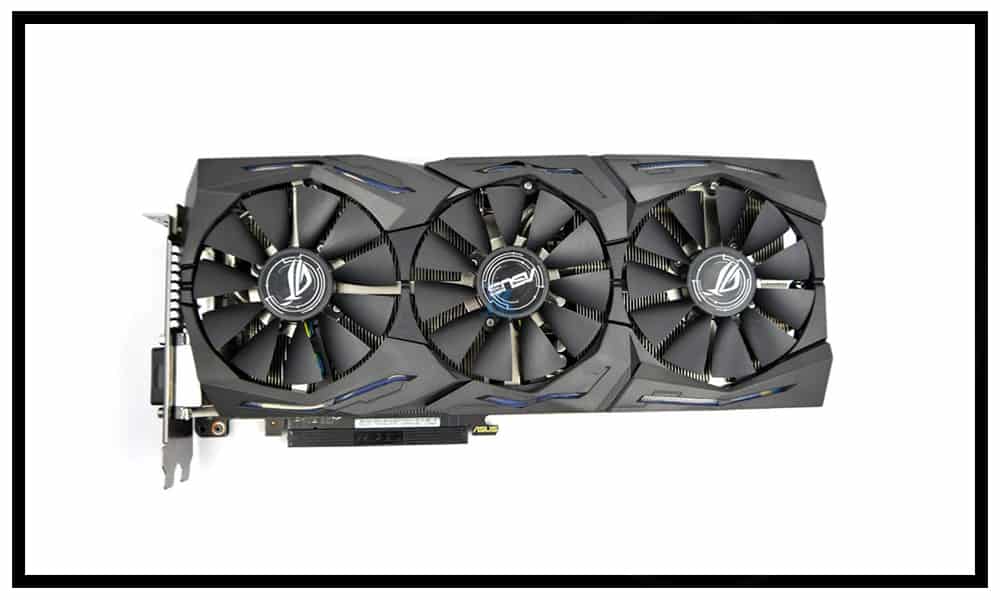
Introduction
The term “Republic of Gamers” commands so much respect in the enthusiast community, that you can almost guarantee, you’re going to get a great product. Since 2006, its stood for innovation and quality that gamers and enthusiasts have grown to expect from the ROG brand. ROG Strix is the newest branding under the ROG name. Ever since the founder’s edition 1070 first launched, I’ve been itching to get my hands on the Strix 1070. Now I finally have it. With how well all Pascal cards have been performing, and the ROG logo on the front, back and sides of the card, it’s almost a slam dunk that the Strix 1070 is going to be an excellent card. However, occasionally, you’ll get that one card that just disappoints you. Whether it can’t overclock well enough, doesn’t run as cool as you’d like, or may even have coil whine. But that’s what we are here to find out, right? So, let’s see if the Strix 1070 lives up to the Republic of Gamers name. Although, I think I already know the answer to that.
About Asus and the Republic of Gamers
“ASUS takes its name from Pegasus, the winged horse in Greek mythology that symbolizes wisdom and knowledge. ASUS embodies the strength, purity, and adventurous spirit of this fantastic creature, and soars to new heights with each new product it creates.”
Asus, or Asustek Computer Inc. is a Taiwanese computer hardware and electronics company based in Taipei, Taiwan. Asus was founded in 1989 by four former hardware engineers from Acer. In 2006, Asus launched its Republic of Gamers, or ROG line up of computer hardware, personal computers, peripherals, and accessories focused toward high-end PC gaming. Today, everything from desk-top PCs, Motherboards, GPUs, peripherals and sound cards have the ROG logo and are favorites of the PC enthusiast community.
About Pascal
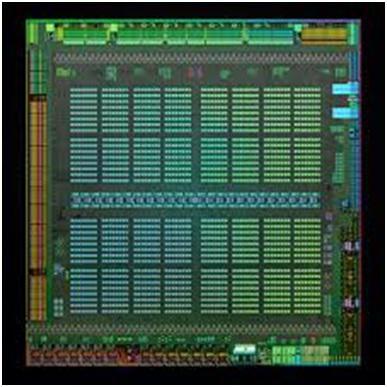
Pascal is designed to offer the highest performance for deep learning and other compute performance. Pascal is Nvidia’s successor to their 28 NM Maxwell Architecture. The Pascal microarchitecture uses the 16 nanometer FinFET manufacturing process from TSMC, the Taiwan Semiconductor Manufacturing Company. With 150 billion transistors, Pascal is the world’s largest FinFET Chip ever built. Delivering over 5 Teraflops of double precision performance, Pascal is also the most powerful architecture ever inside of a GPU.
Features & Specifications
| Product Specifications | |
|---|---|
| Graphics Engine | NVIDIA GeForce GTX 1070 |
| Bus Standard | PCI Express 3.0 |
| OpenGL | 4.5 |
| Video Memory | GDDR5 8GB |
| Core Clock | OC Mode: GPU Boost Clock = 1860 MHz, GPU Base Clock = 1657 MHz Gaming Mode: GPU Boost Clock = 1835 MHz, GPU Base Clock = 1632 MHz |
| CUDA Cores | 1920 |
| Memory Clock | 8008 MHz |
| Memory Interface | 256-bit |
| Max Resolution | 7680x4320px |
| Interface | 1 x DVI-D 2 x HDMI 2.0 2 x Display Port 1.2 HDCP Support: Yes |
| Accessories | 2 x ROG Cable Ties Power Connectors 1 x 8-pin |
| Software | ASUS GPU Tweak II & Driver |
| Dimensions | 11.73 ” x 5.28 ” x 1.57 ” Inch 29.8 x 13.4 x 4 Centimeter |
Packaging & Unboxing
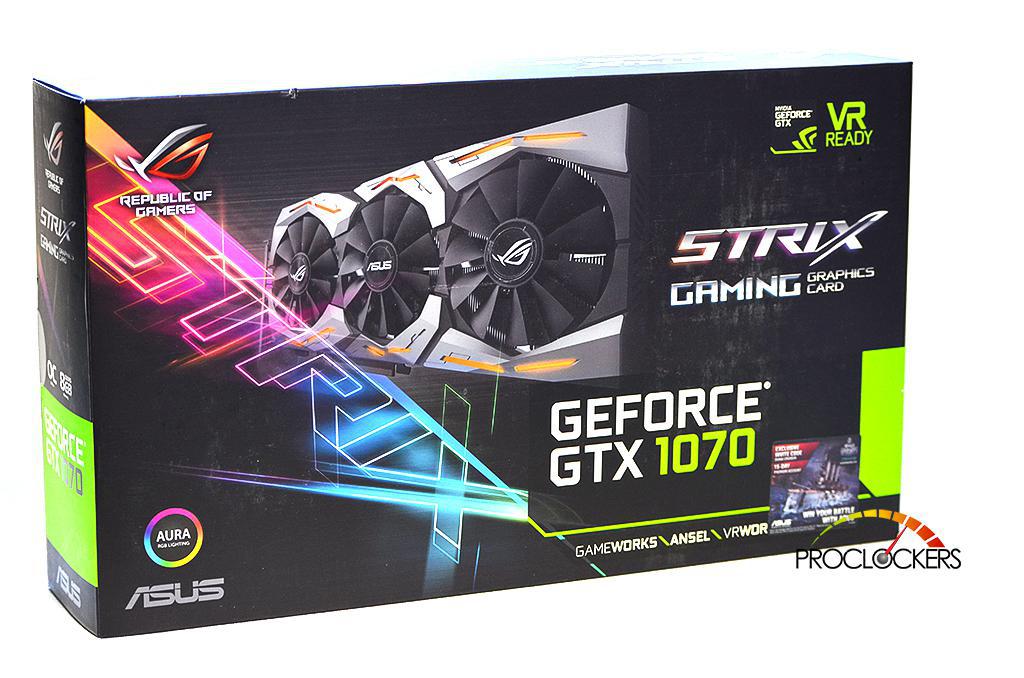
The STRIX 1070 comes in an attractive box, with the Republic of Gamers logo in the top left hand corner. Below the ROG logo is the STRIX branding, the ASUS logo and the AURA lighting logo as well. In the center of the box, near the top, there is a depiction of the STRIX 1070 card. On the right, from top to bottom, you see the Nvidia GeForce GTX logo and VR Ready logo. Just below is the STRIX branding and the words “Gaming Graphics Card.” The bottom right corner has the GeForce GTX logo and 1070 product branding. There is also a list of a few of the main features of the GeForce GTX line up. These include NVidia’s GameWorks, VR Works and Ansel. Lastly, there is an advertisement for a 15-day premium account for World of Warships.
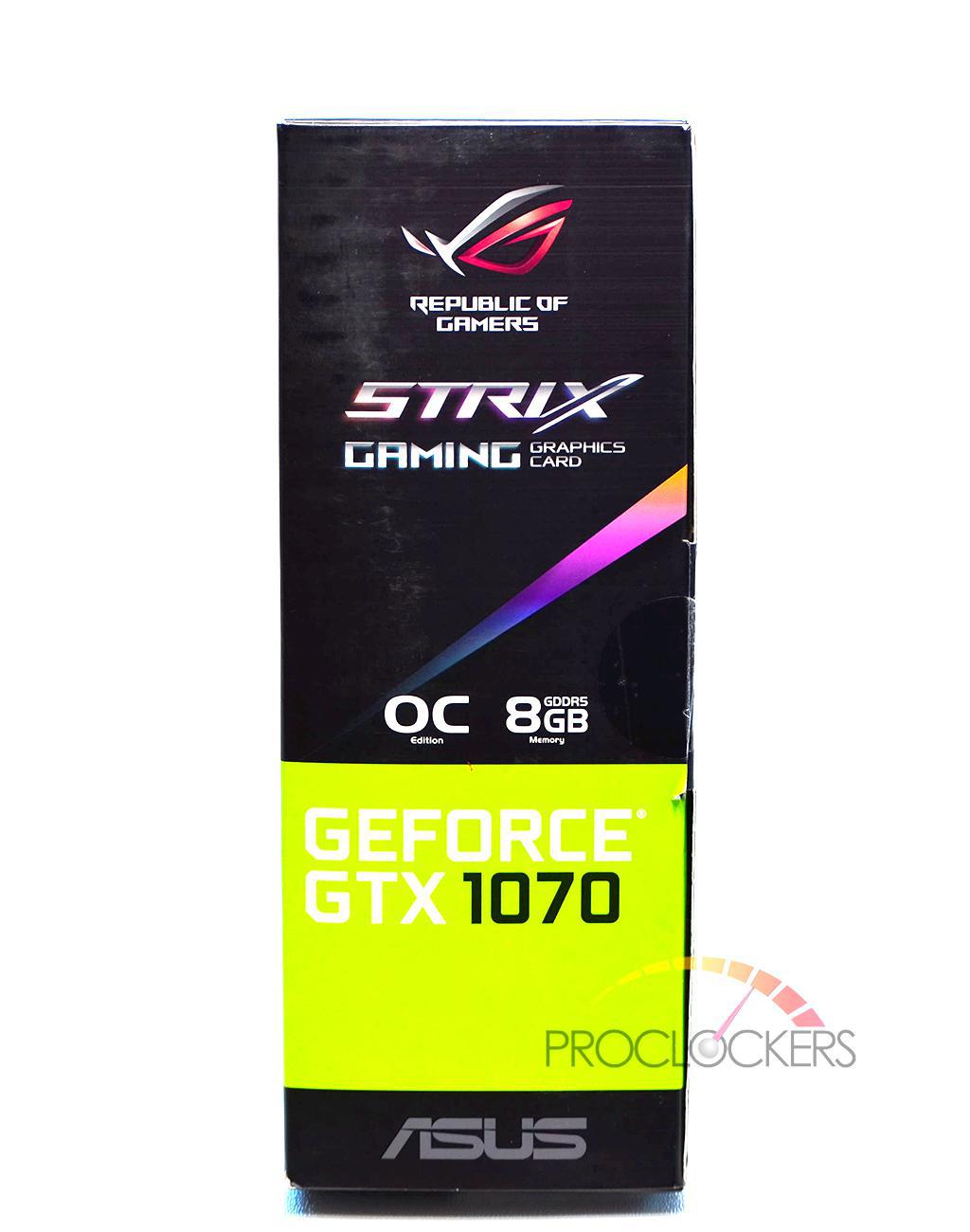
The left and right side of the box are identical. The have the ROG and ASUS logos, Strix and GeForce GTX 1070 branding.
The rear of the package has a lot of information on it. Across the top, from left to right, you first see the ROG logo followed by the STRIX Gaming Graphics Card Branding. Next is the Nvidia GTX 1070 logo and branding, followed by the mention of a 3-year warranty and the HDMI certification.
The back of the package also makes note of several key features of the STRIX 1070. Some of the features mentioned are the Direct CU III cooler with their patented Wing-Blade Fans. Also, their Auto-Extreme Technology, “VR Friendly” HDMI Ports, Asus Fan Connect, GPU Tweak II and AURA RGB Lighting. On the very bottom of the box are the main specifications of the STRIX 1070 and a depiction of the lay out of the IO of the card.
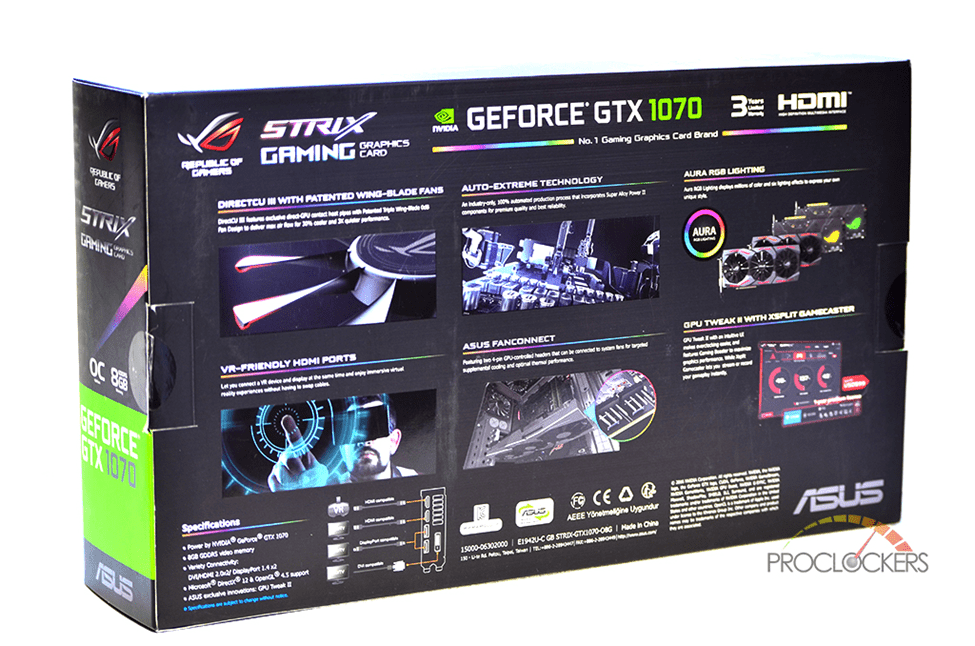
The rear of the box had depiction and descriptions of several the main features of the STRIX 1070.
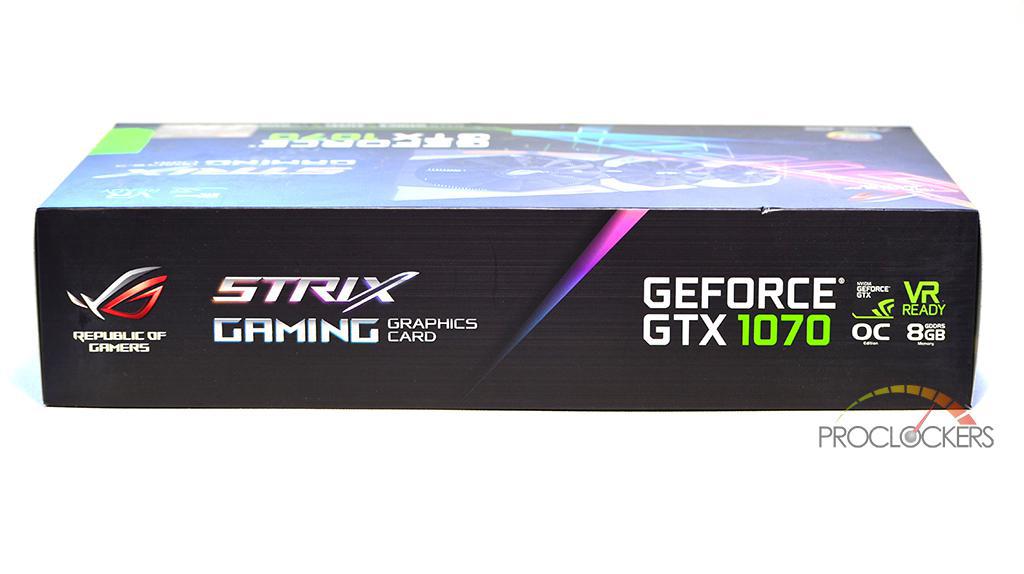
From Left to right, The top of the box has the ROG logo and Strix branding, and the GeForce GTX 1070 branding.
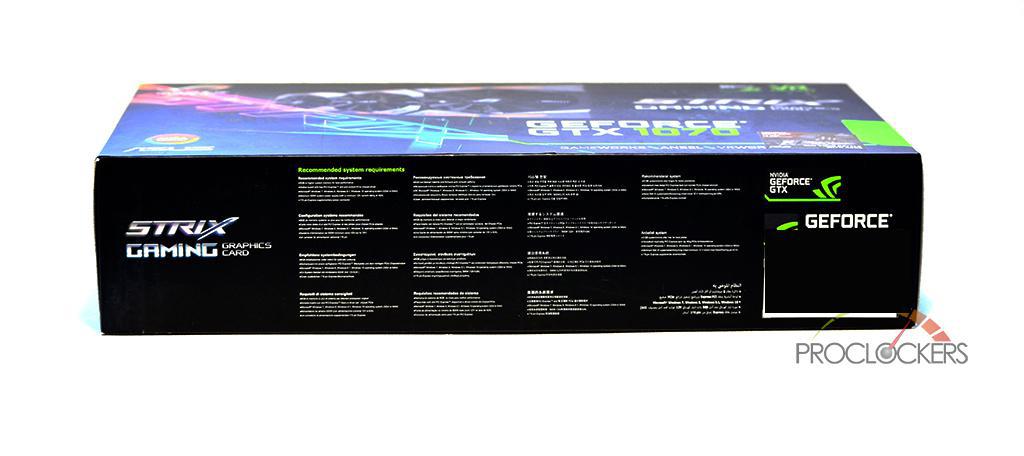
The bottom lists the Recommended System Requirements in several languages. This is also where you’ll find information such as model and serial numbers and the UPC code.
The Top of the box has the distinct ROG logo and Strix product branding to the left. To the right, The GeForce GTX 1070 branding, along with a bit more information. Such as it being the OC Edition, and having 8 GB of VRAM. The very bottom of the box has the recommended system requirements in several languages. To the far right, you see the UPC code, model and serial number. Both the left and right sides of the box are the same. The have the ROG logo and Strix branding near the top. In the middle, you see the OC edition and 8gb features. Lastly are the GeForce GTX 1070 branding and the Asus logo.
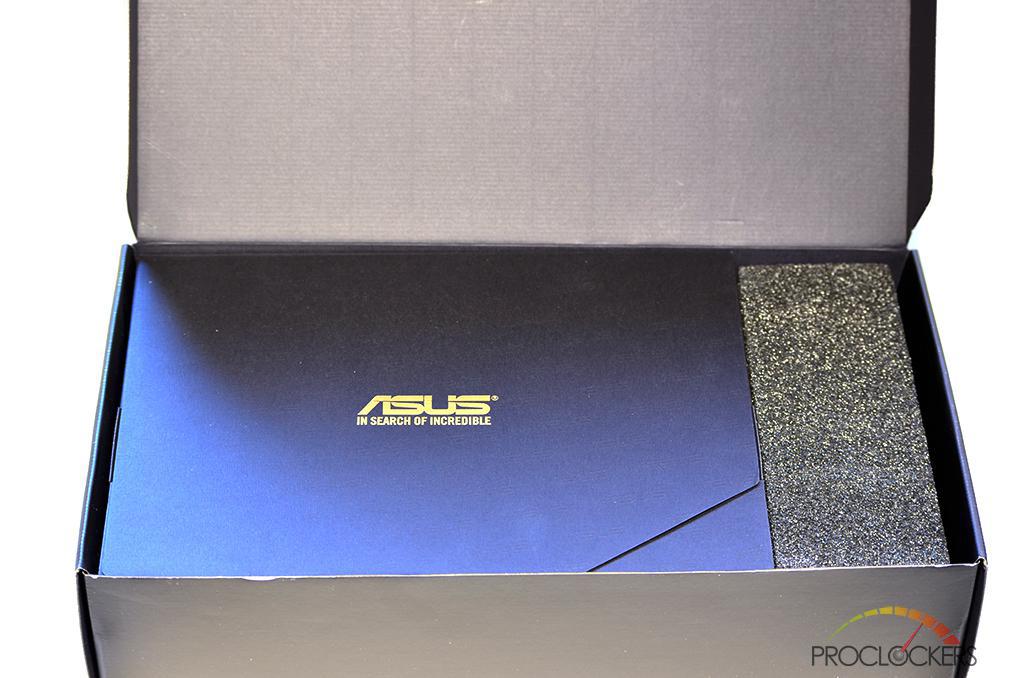
Both the accessory box and GPU come packed in soft foam.
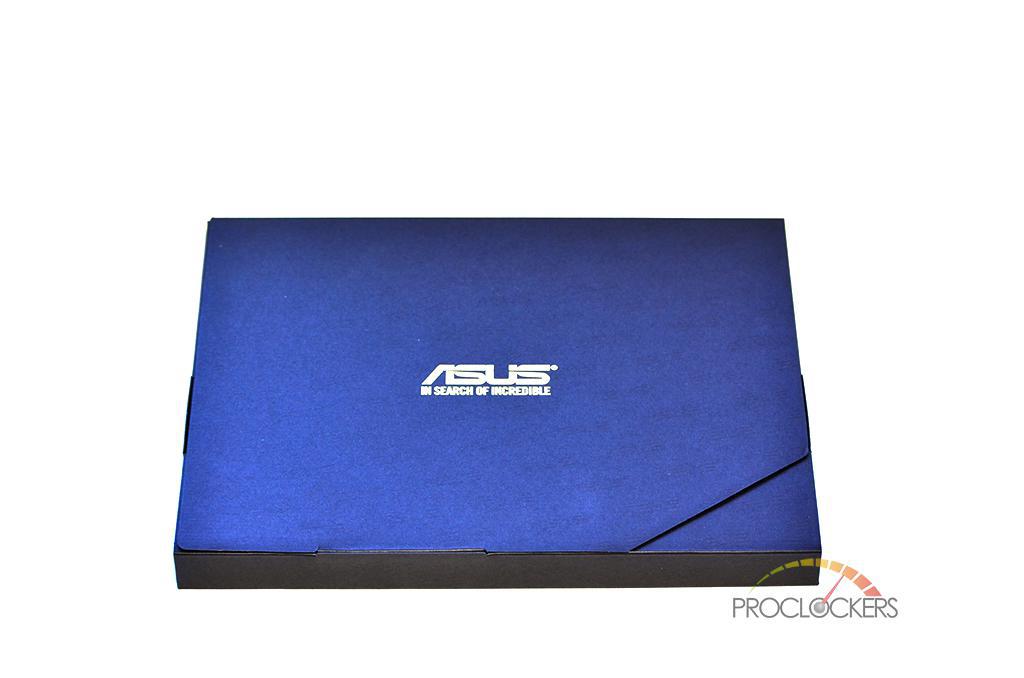
The smaller box with Asus printed on it is where you’ll find any accessories.
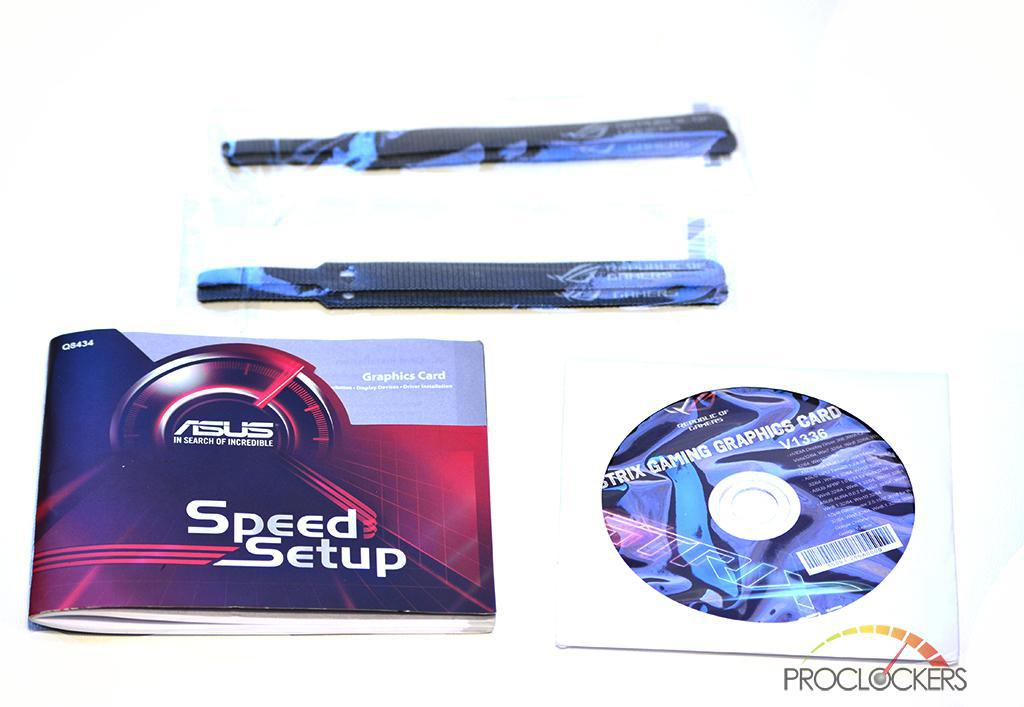
The Accessories include a driver disk, user manual and Velcro straps.
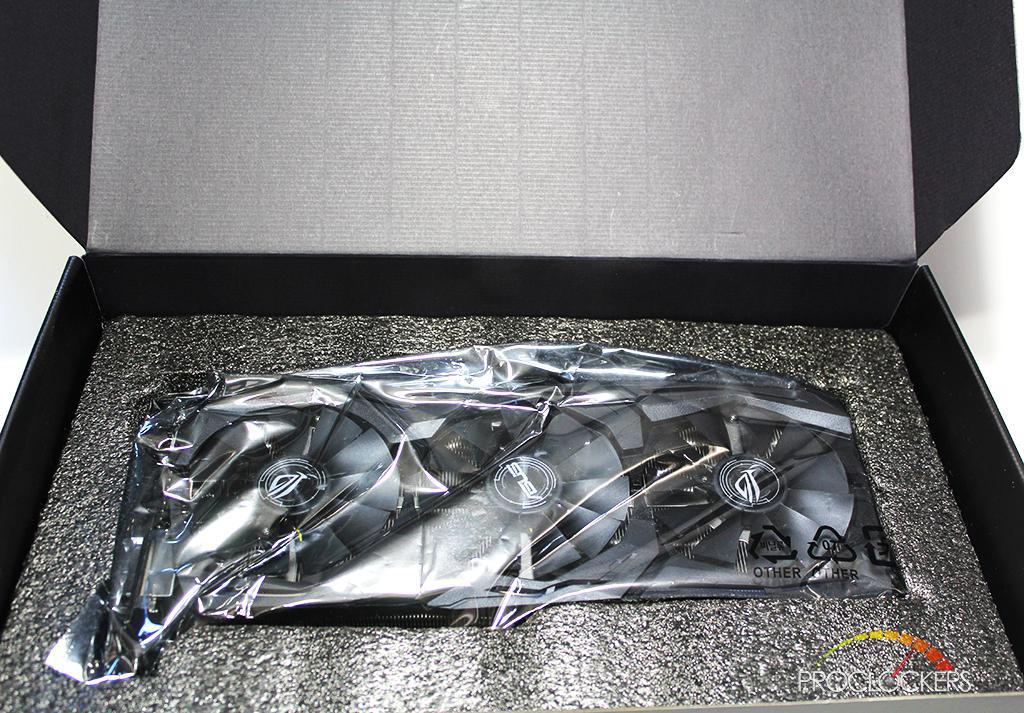
The card comes wrapped in an anti-static bag and packed in soft foam.
When first opened, you see the inner box and the word “STRIX” printed on the side. When you slide out the inner box and open it, you find a sheet of soft foam covering a small box with the Asus logo printed on it. This box contains the user manual, driver disk and a few Velcro straps to help with cable management. Under this box, as well as a small block of soft foam, we find the STRIX 1070 wrapped in an anti-static bag and in cased in soft foam.
A Closer Look
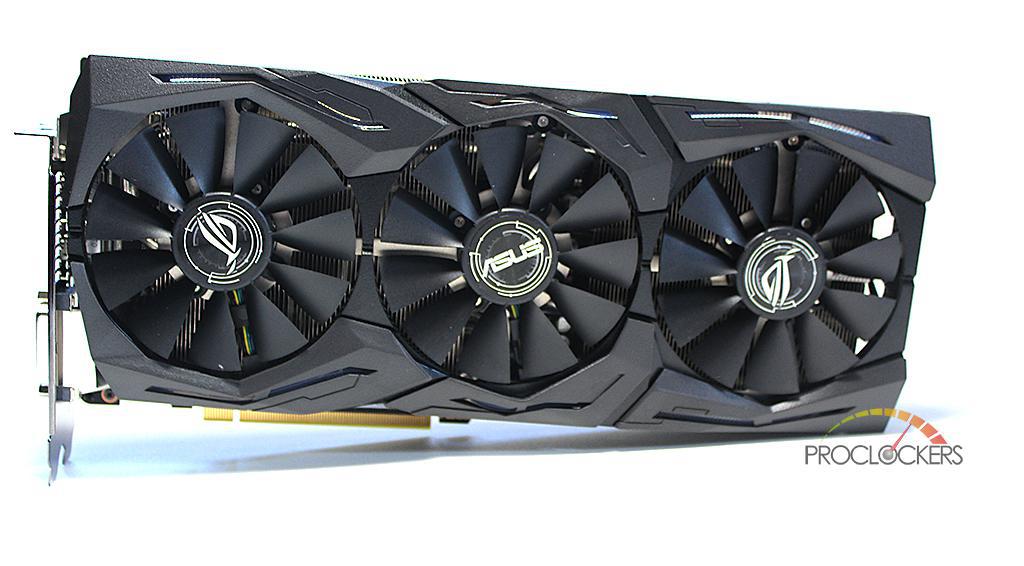
Each of the 3 fans on the front of the STRIX 1070 have RGB lighting on the top and bottom of each fan.
When compared to the STRIX 970, there are several things that set the STRIX 1070 apart. I’d say the 1070 is an upgrade in almost every way. The first thing you see is the STRIX 1070 is a 3 fans cooler. On the top and bottom of each fan, you find LED zones for the AURA RGB lighting on the front and back of the graphics card. The second RGB zone would be the large, ROG logo on the back plate of the card. The 3rd and final RGB zone are the words Republic of Gamers on the side of the card.
It’s worth noting that all ASUS graphic cards are manufactured using their Auto-Extreme Technology. This process is exclusive to ASUS and 100% automated and incorporates the highest quality materials. This also ensures that consistency while making the graphics cards. It also eliminates the human error side of things. Lastly, this new manufacturing process is more environmental friendly by reducing power consumption of the plant by almost 50% as well as eliminating chemicals.
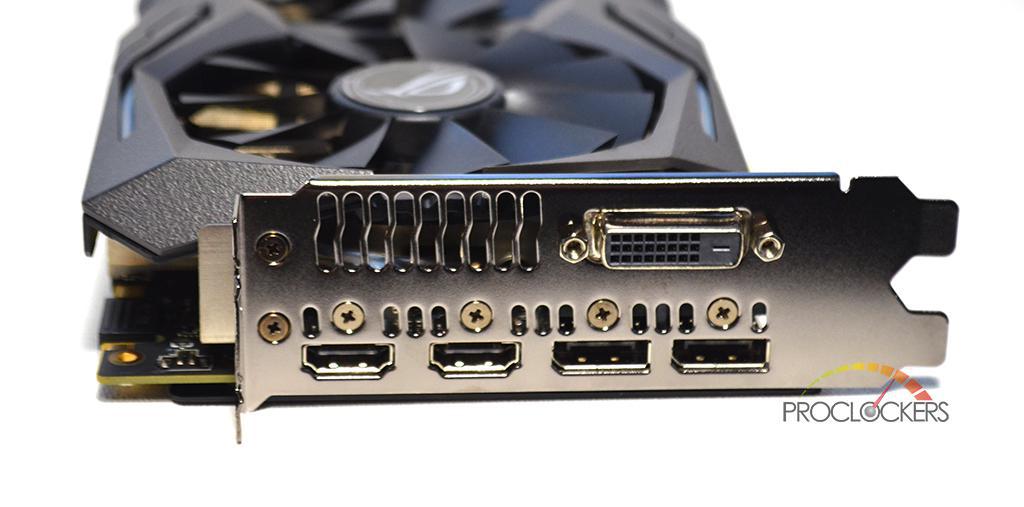
The IO on the STRIX 1070 is considered VR Ready with its 2 HDMI 2.0 ports. It also had a DVI-D and 2 Display Ports.
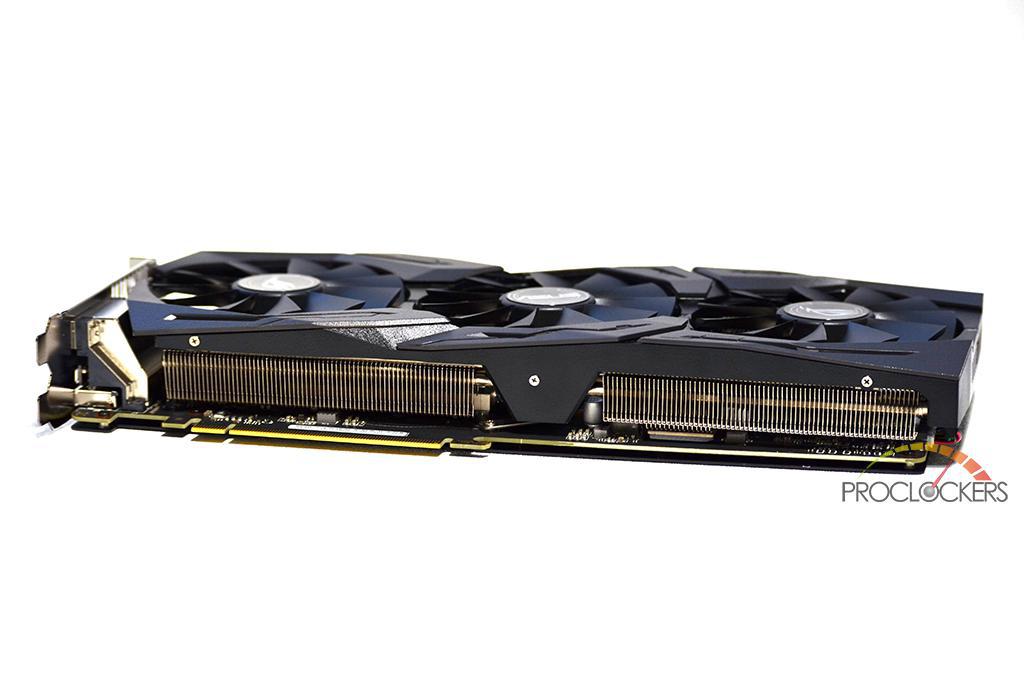
The Direct CU III cooler runs the entire length of the card.
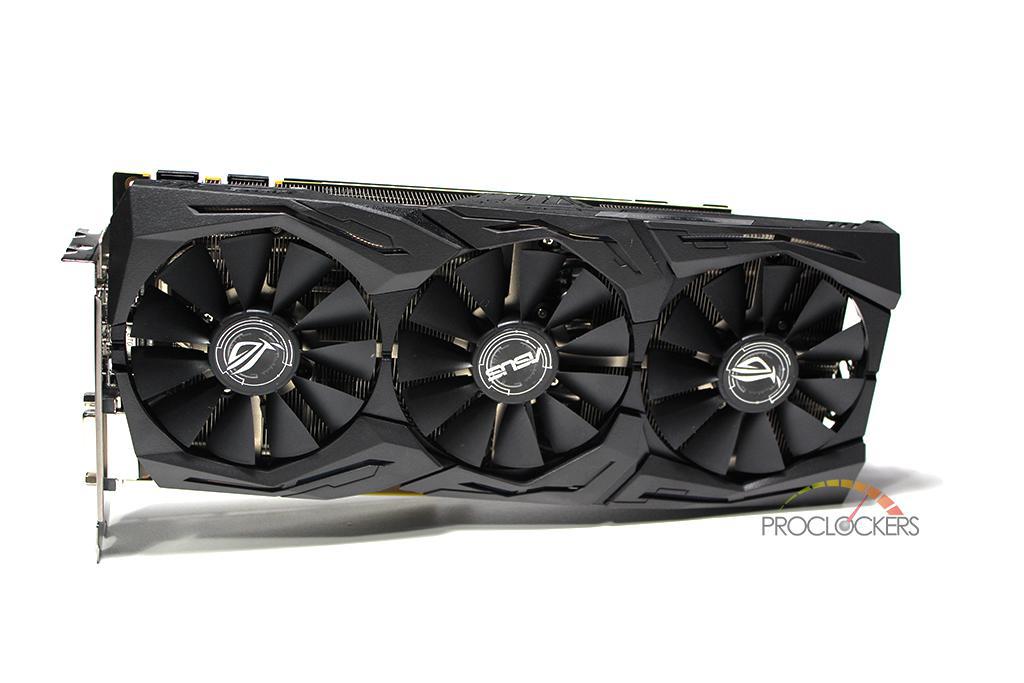
The front of the card has 3 fans with RGB lighting above and below each fan.
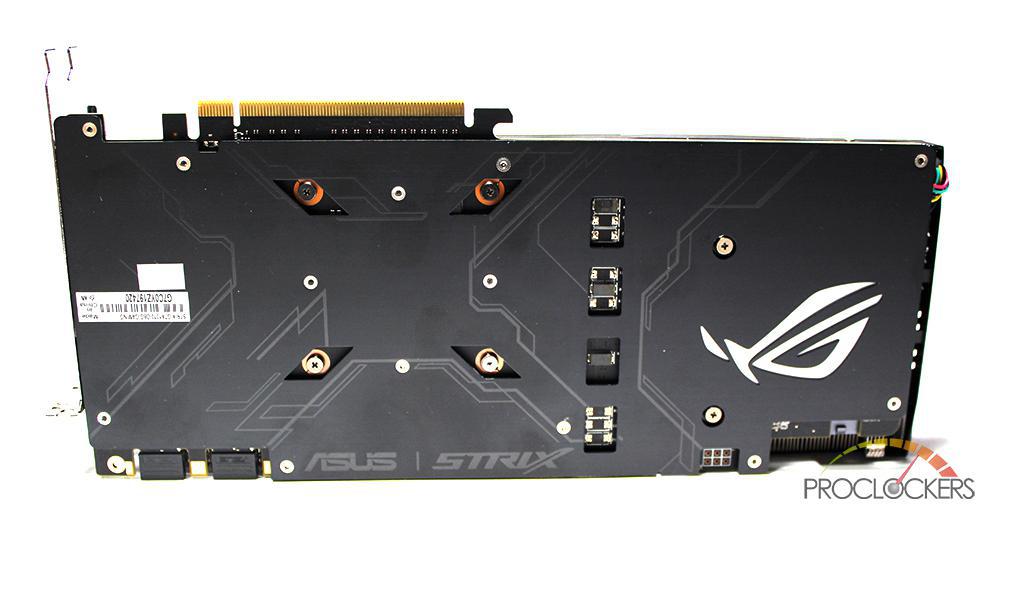
The rear of the card has the ASUS STRIX branding and the ROG logo with RGB back lighting.
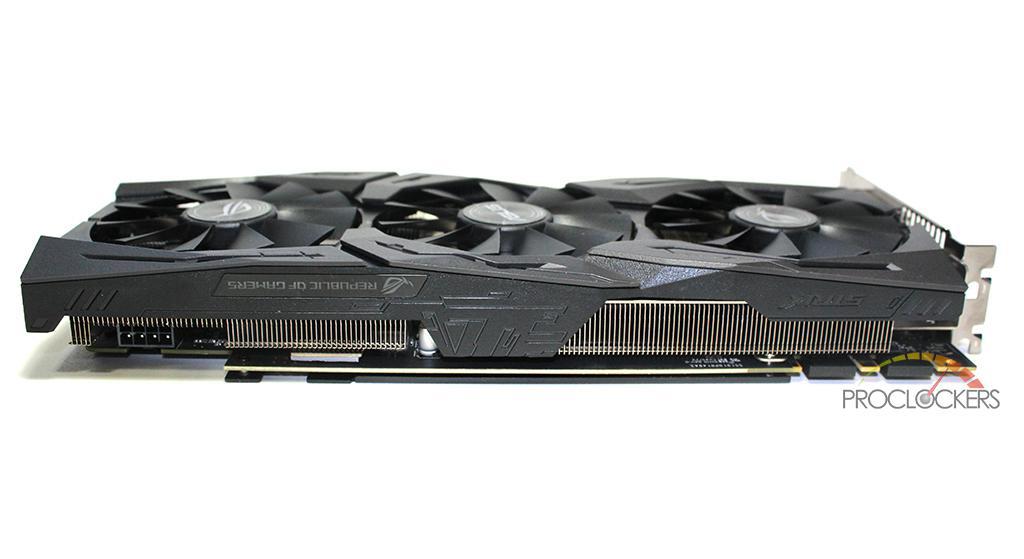
The top side of the card has the 3rd RGB zone as well as the STRIX branding.
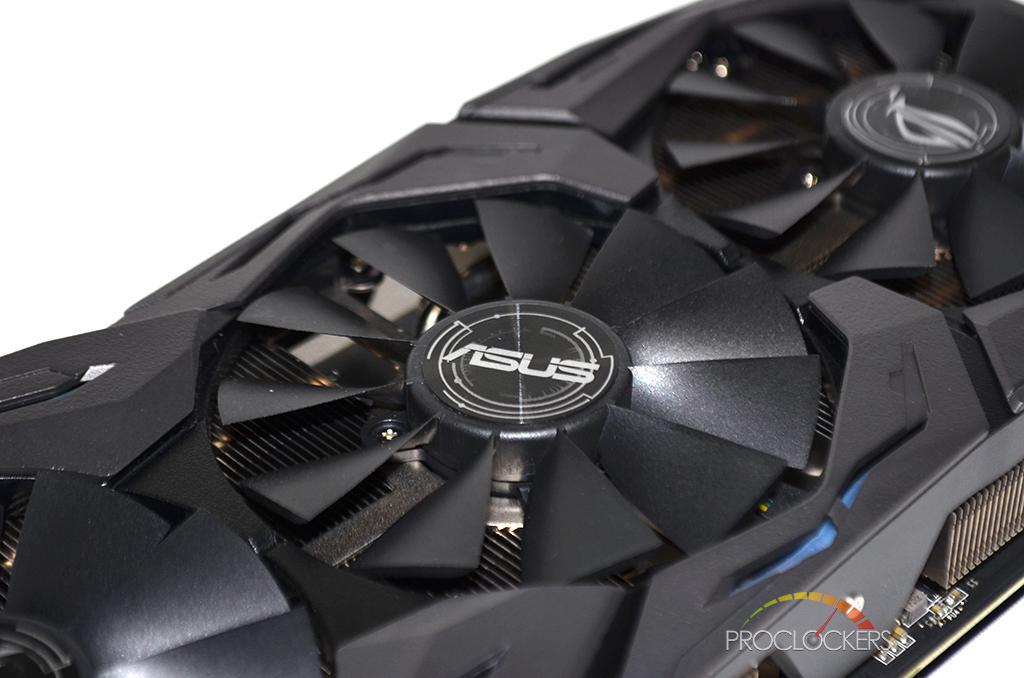
A closer look at the front of the card reveals the RGB lighting on the top and bottom of the 3 fans.
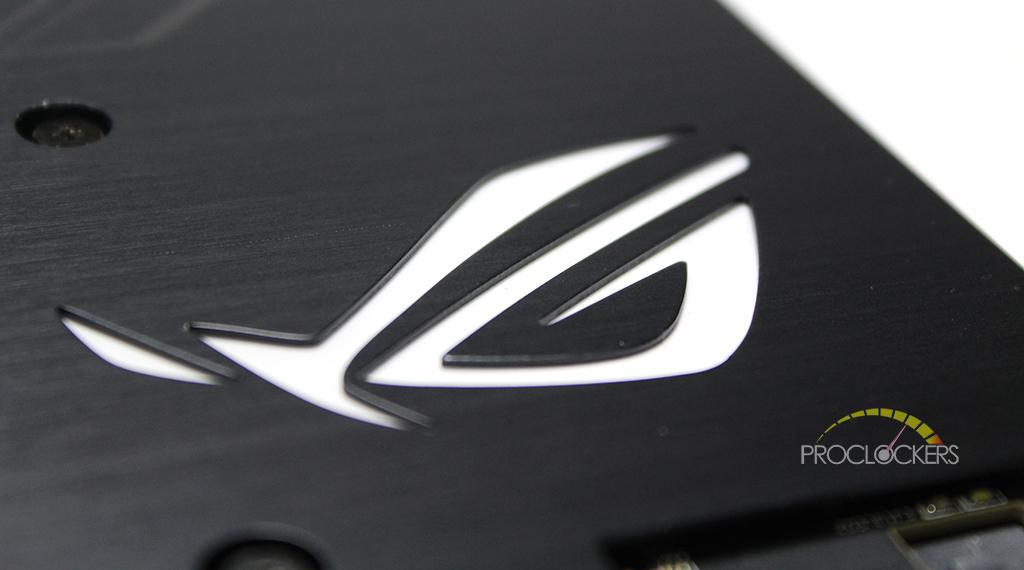
The ROG Owl Eye logo on the rear of the GPU is another RGB zone on the STRIX 1070.
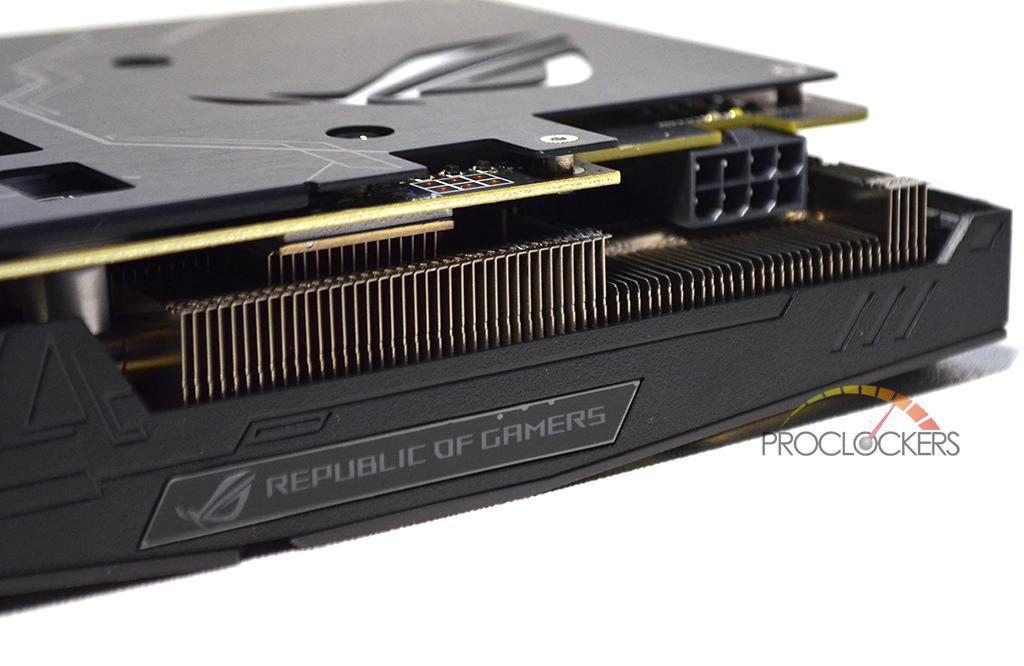
The final RGB zone is on the side of the card with the Republic of Gamers branding is.
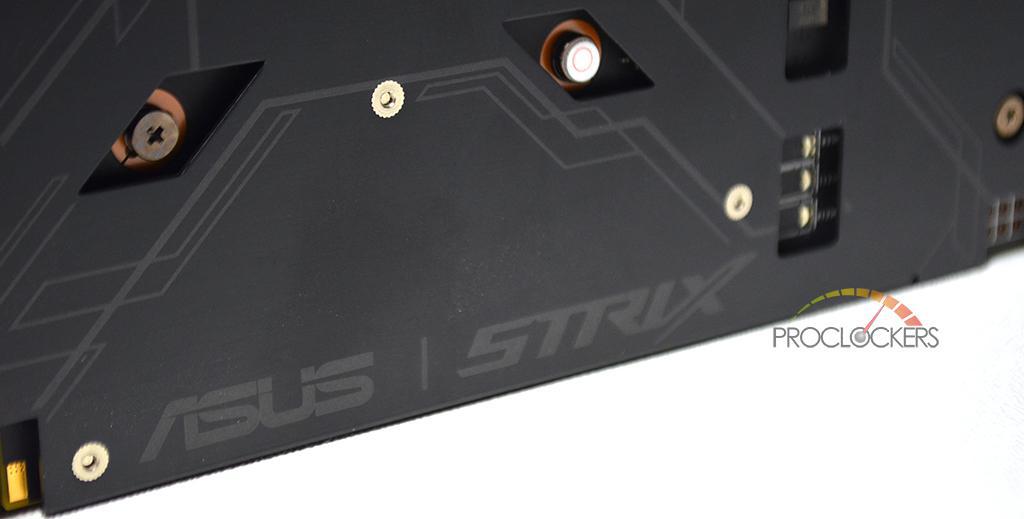
The back plate also has the Asus logo and STRIX branding on it.
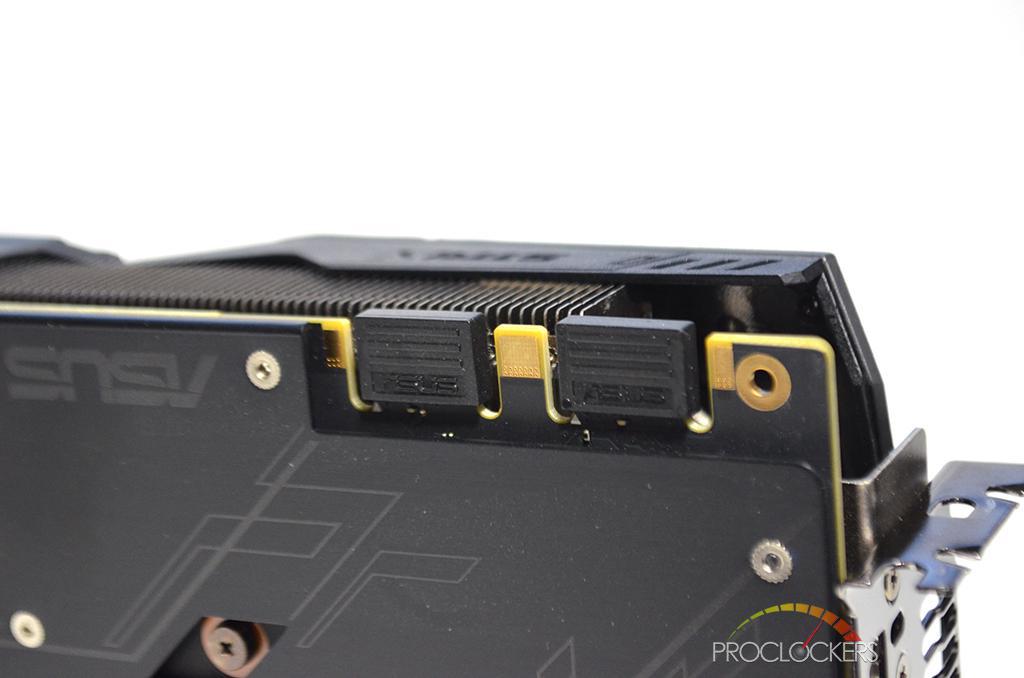
Although the card can technically support up to 4-way SLI, driver support only supports up to 2-way SLI.
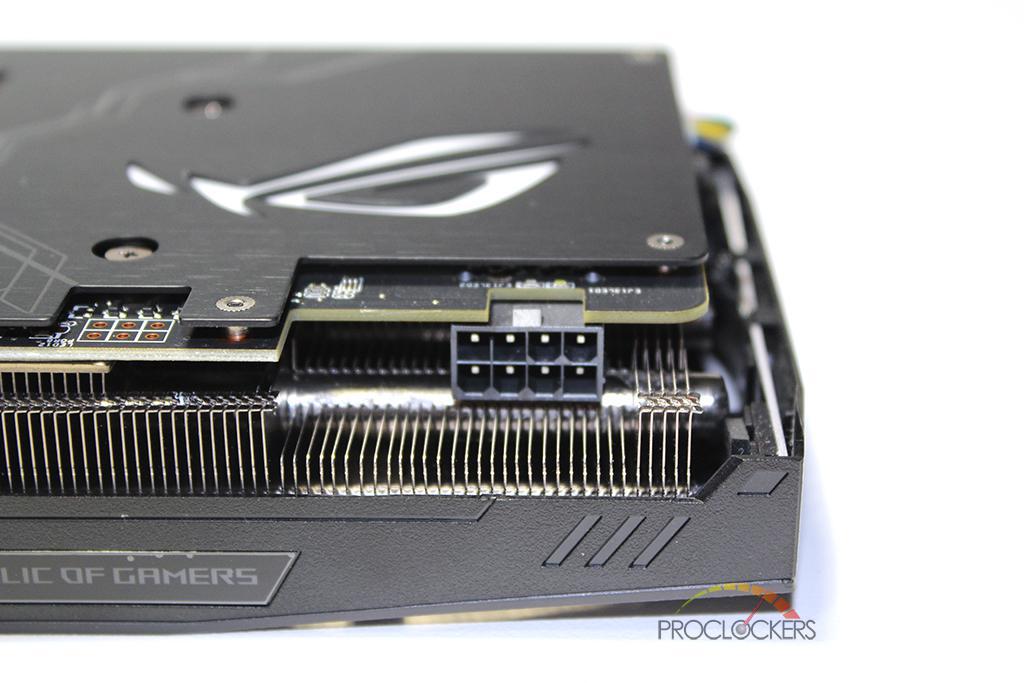
The STRIX 1070 requires a single 8-pin power connector.
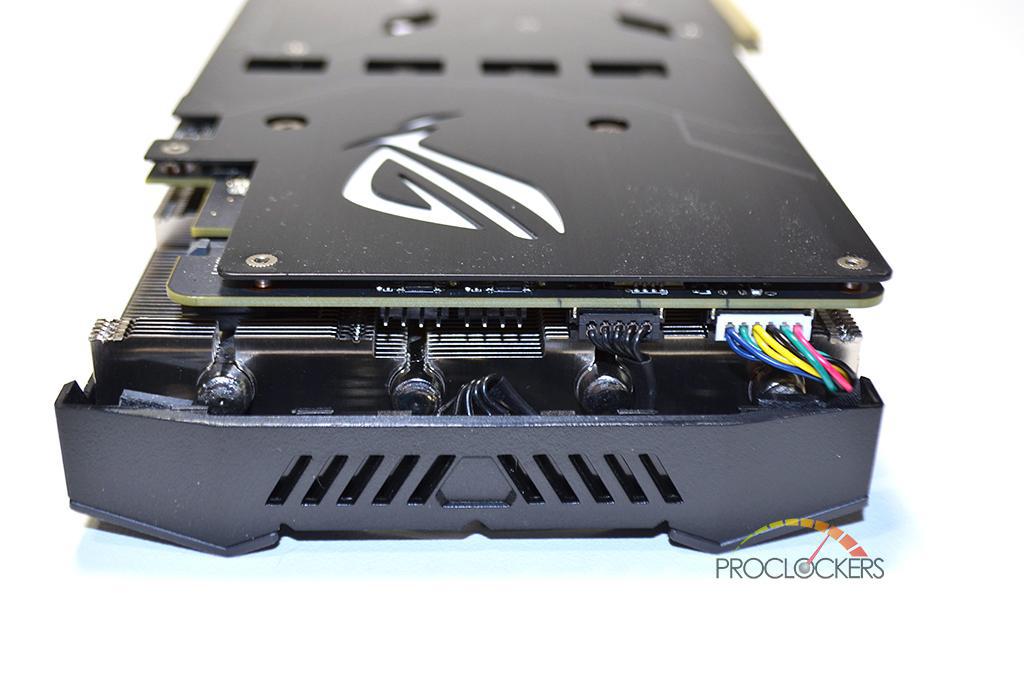
ASUS FanConnect features 2 x 4-pin GPU-controlled headers connected to system fans. This allows the user to add 2 additional fans that will be controlled by the card.
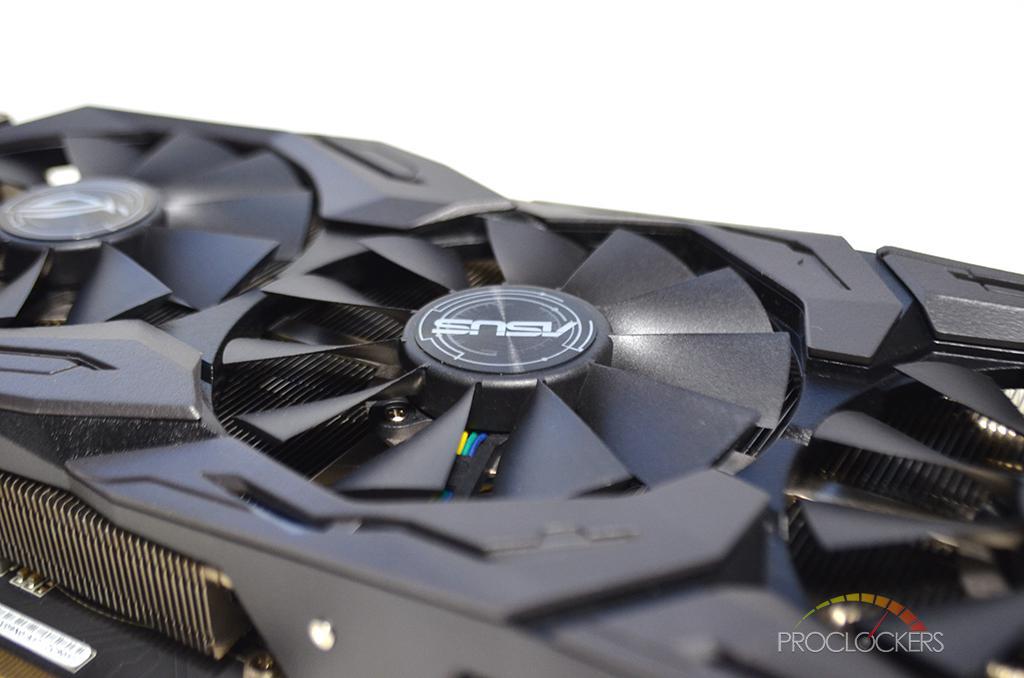
Their patented Wing-Blade Fans are designed for 30 times quieter performance and a 30% increase in cooling capability.
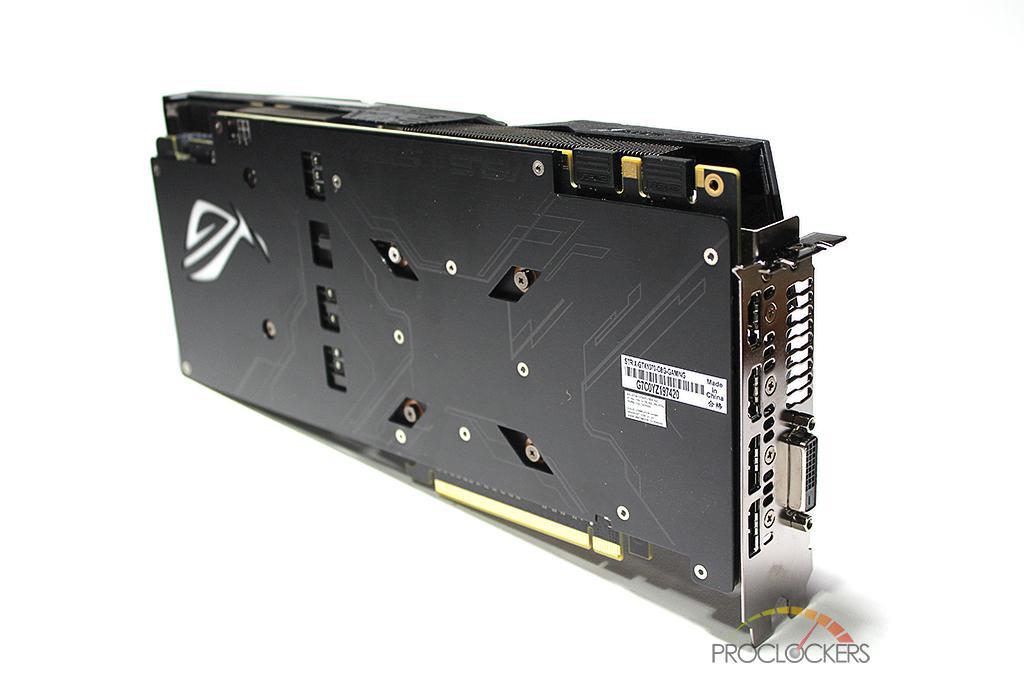
When you look at the rear of the GPU, you see the 6 screws that hold the cooler on the custom PCB of the STRIX 1070.
The IO on the STRIX 1070 isn’t your average IO. This is since it’s considered “VR Ready” with 2 x HDMI 2.0 ports. The STRIX 1070 also has a single DVI-D and 2 Display Ports. I would have rather kept the third DisplayPort over the DVD-D. However, it is good to have a DVI-D port as well. As you look down the side of the card, you’ll see the standard PCIe connection. You can also see how thick the Direct CU Cooler is. Running the entire length of the custom PCB, the heatsink is made up of 5 copper heat pipes that make direct contact with the GPU Die.
DirectCU III is equipped with 3 0dB fans engineered with a patented wing-blade design. The STRIX cooler delivers maximum air flow and improved 105% static pressure over the heat sink. At the same time, operating 3X quieter than reference cards.
Asus FanConnect is another great feature of the STRIX 1070. In just about all systems, the case fans are controlled through the motherboard, and designed to help keep the system cool. However, the Strix 1070 has 2, 4-pin fan headers on the rear of the card, near the 8-pin power connector. This allows you to have two case fans controlled by the GPU instead of the CPU. This way, you can optimize air flow to help keep the GPU cool.
When you look along the top of the card, you see the SLI fingers. Although the card can technically support up to 4-way SLI, we all know that Nvidia is only giving driver support up to 2-way SLI. There are a few exceptions to this tough. There are a few synthetic benchmarks, such as 3DMARK, that allow 3 and 4-way SLI. Game developers do have the option to offer 3 and 4-way SLI support, but few, if any do.
It’s great to see the ROG STRIX 1070 with a back plate. It’s even better to see that back plate with RGB lighting. There are a series of 6 screws that hold the cooler to the PCB. To remove the back plate, you must first remove the cooler. Then, you must remove several tiny screws on the PBC to remove the back plate from the PCB. Unless you were putting a water block, I’d see no reason to remove the back plate. Especially since it’s RGB backlit.
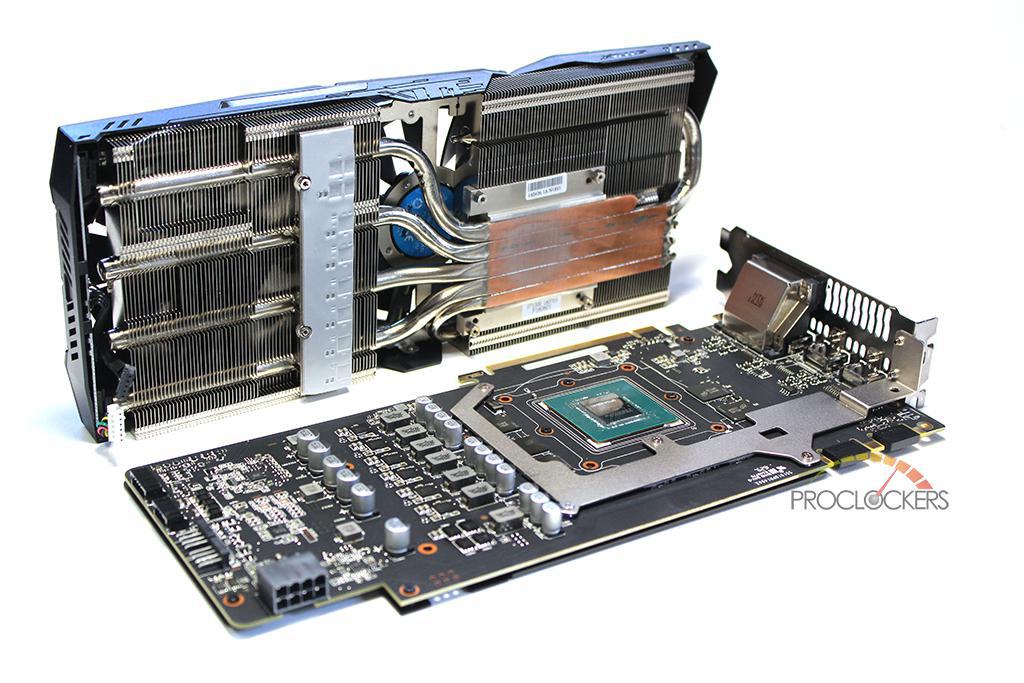
The first thing I noticed when the card was pulled apart was the thermal pads for the 6+1 phase power delivery.
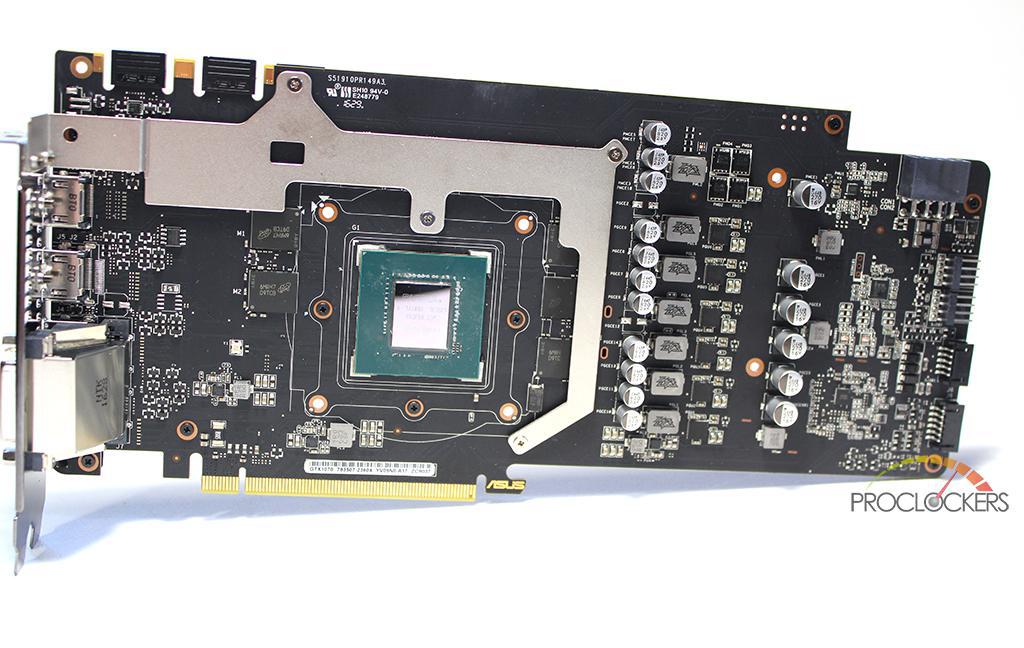
Here you see the custom PCB of the STRIX 1070. To remove the back plate, you must unscrew it from this side of the PCB.
The STRIX 107 is equipped with a 6+1 phase power delivery. Asus has used premium alloy components in their graphics cards. Their Super Alloy II Components increase the efficiency, reduce power loss and achieve thermal levels that are almost 50% cooler than previous generations of STRIX cards. Some of the benefits of the Super Alloy II Components are quieter choke and 2.5 times the lifespan of the capacitors. The capacitors are rated at about 90,000 hours longer than normal capacitors. The DrMOS run about 20% cooler. The power delivery is overall designed to decrease temperatures and increase both overclocking performance and efficiency.
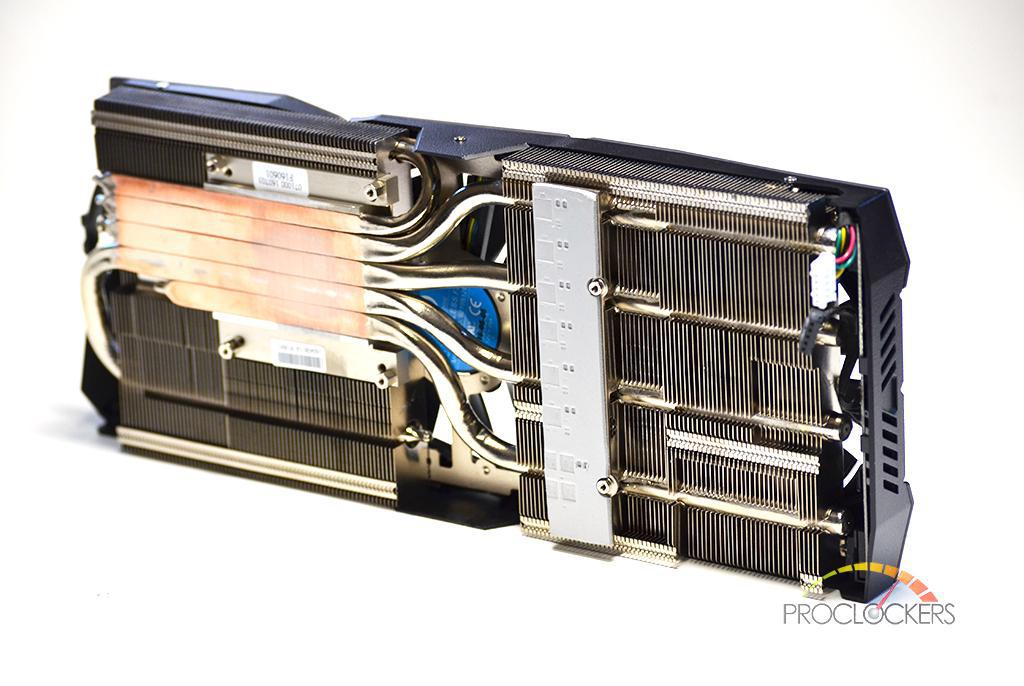
This is the massive heatsink on the ROG STRIX 1070.
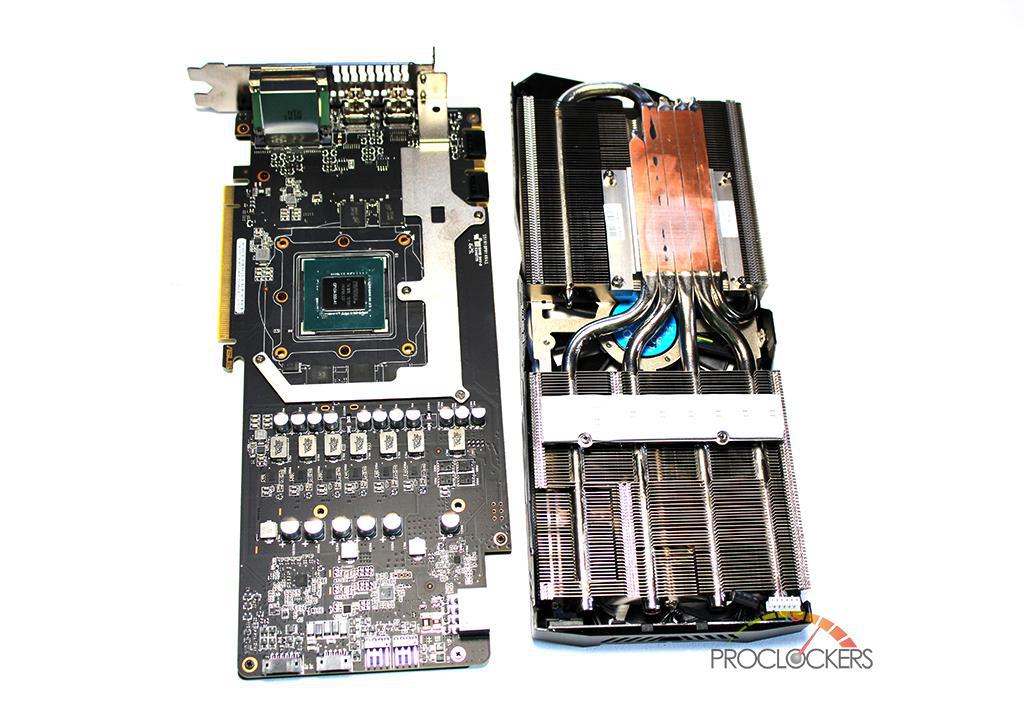
The cooler and PCB side by side. Once they are apart, you can truly appreciate the weight of the Direct CU III cooler.
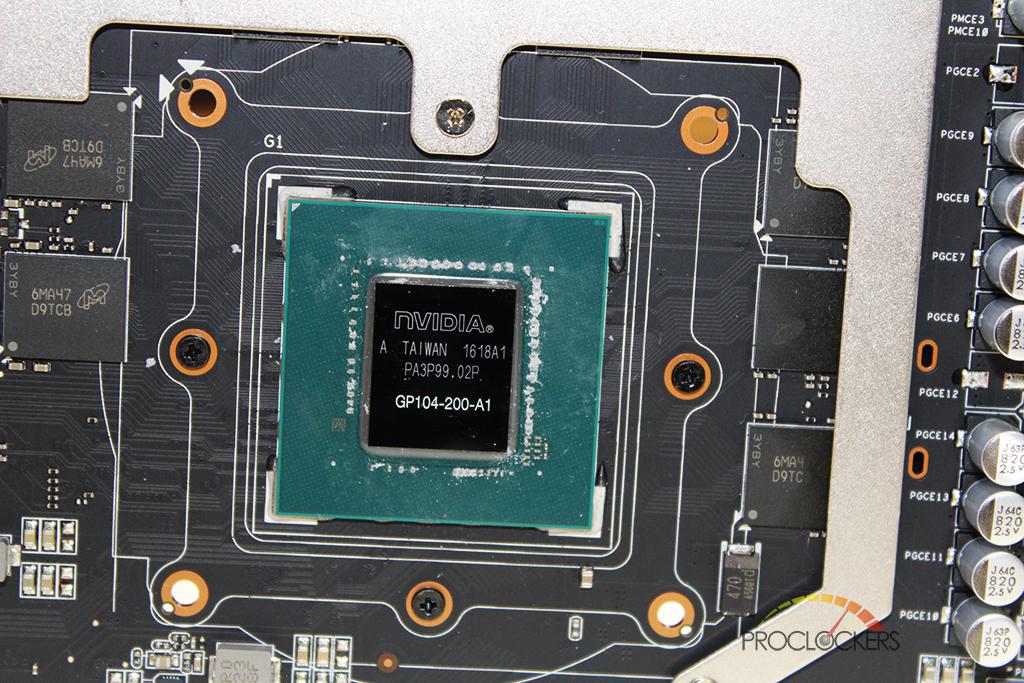
The STRIX 1070 has the GeForce Pascal, or GP104-200-A1 GPU Nvidia, with 1920 CUDA Cores affixed to the custom PCB with a 6+1 phase power delivery.
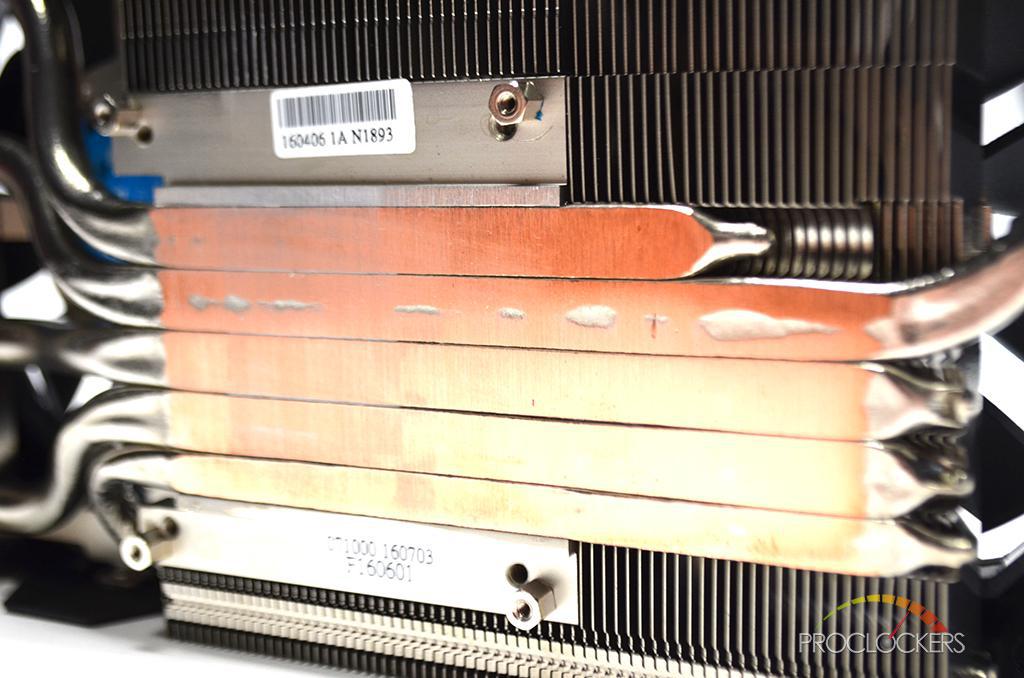
5 Copper heat pipes make direct contact with the GPU Die.
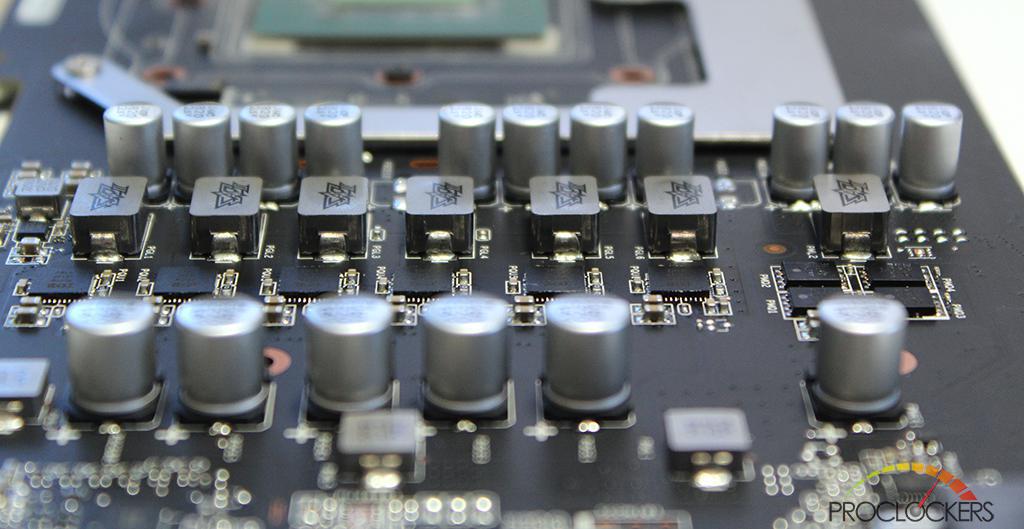
The 6+1 phase power delivery is made up of Asus’s Auto-Extreme Technology with Super Alloy Power II.
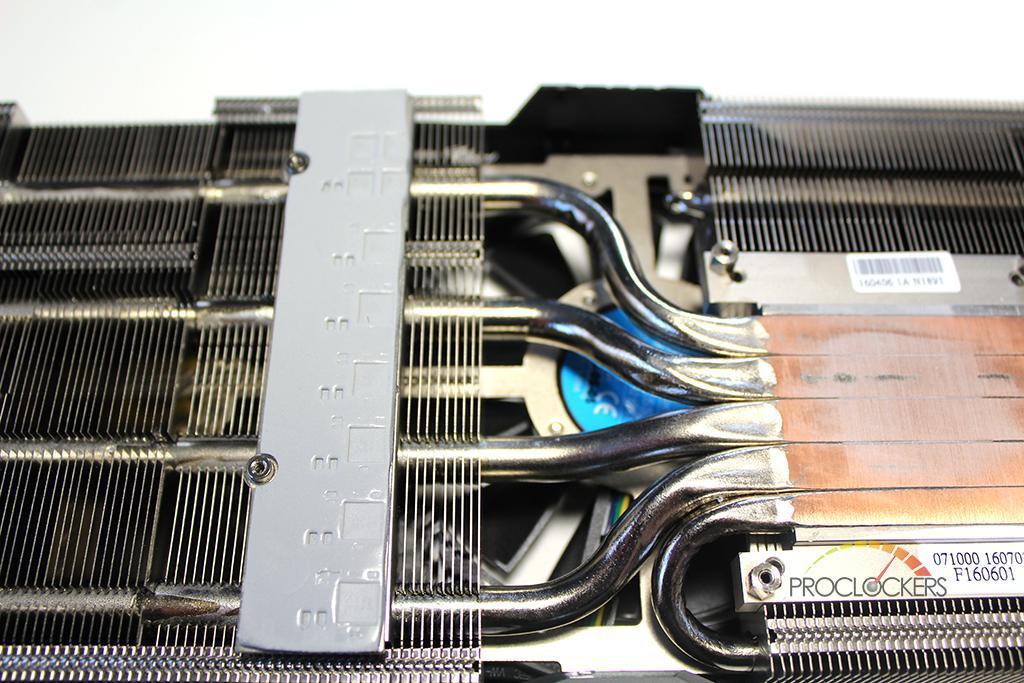
The power delivery has this large thermal pad between itself and the heatsink. You can also see there is a fan directly above the heat pipes.
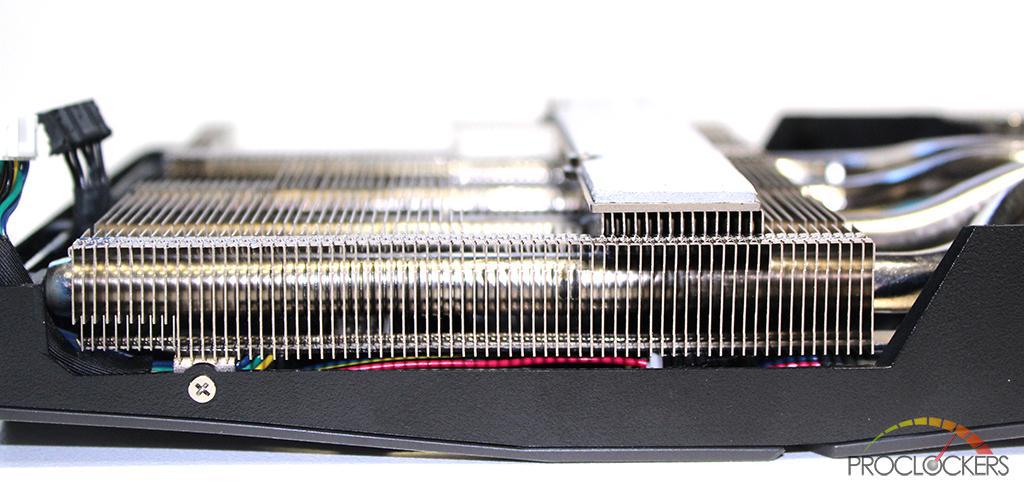
This picture shows not only how thick the heatsink is, but also how thick the thermal pad for the power delivery is.
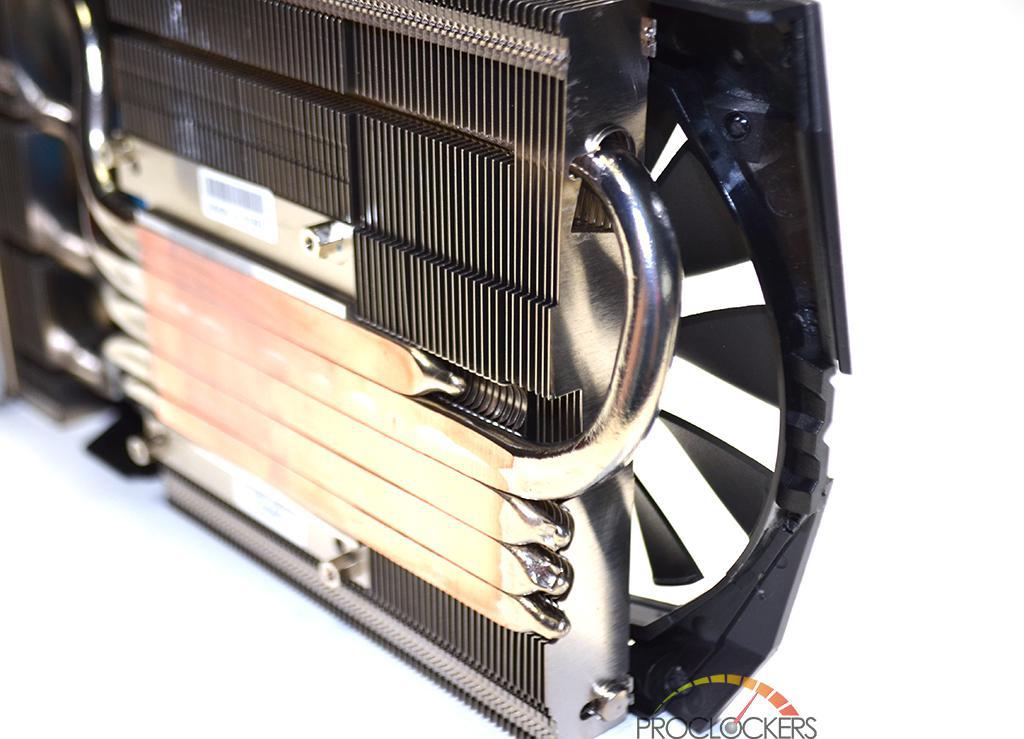
The back end shows us that the heat pipes loop through the entire heatsink.
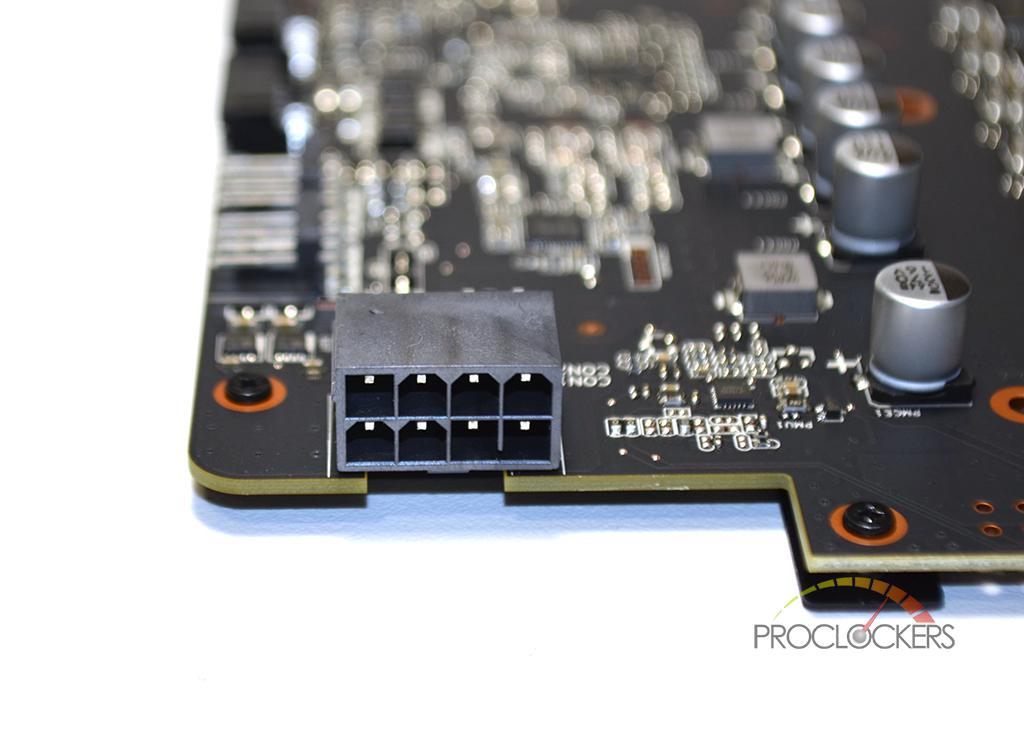
As mentioned before, The Asus STRIX 1070 has a single 8-pin power connector.
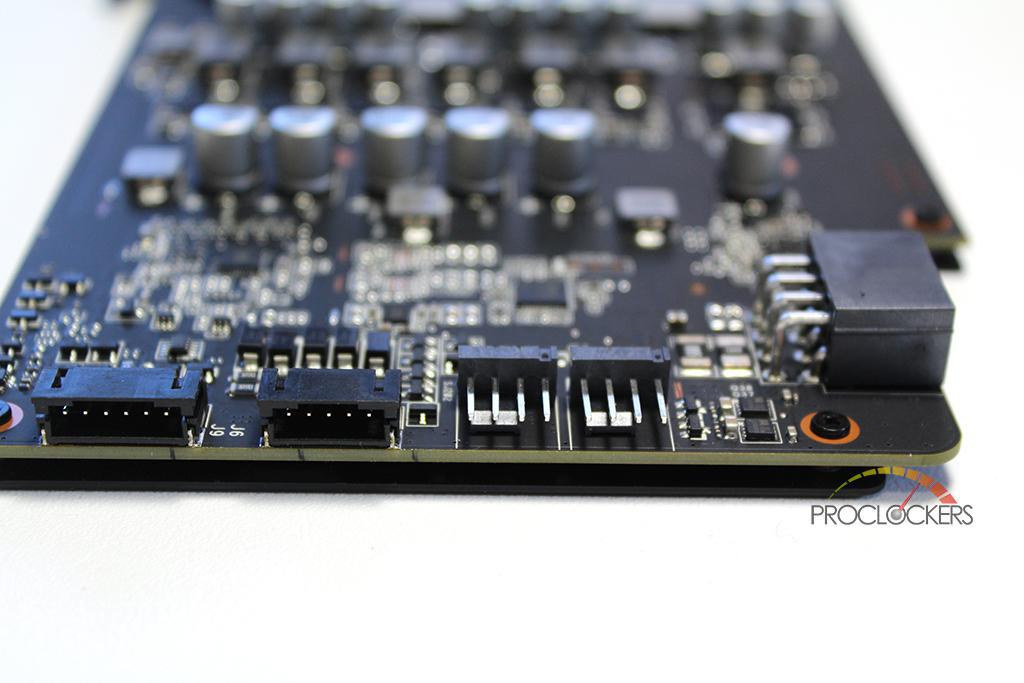
The ROG STRIX 1070 has 2 x 4-pin fan headers on the card itself. This allows the GPU to control 2 case fans on top of the 3 fans on the cooler.
AURA Lighting
“Where Style Meets Performance”
This is the AURA Lighting menu.
With the AURA Lighting control software, you can control each RGB zone on the Graphics Card, Motherboard, RGB Strips and anything certified to work with the AURA software. On the Strix 1070 the RGB zones are on the back plate and the front and side of the shroud. Each zone can be set individually or can be synced, even with other AURA certified peripherals, RGB Strips and motherboards. There are 6 modes to choose from. These modes are as follows:
- Static: The light is always on
- Breathing: Lighting fades and out.
- GPU Temperature: Changes color when the GPU hit specific temperatures
- Color Cycle: fades between all the colors of the color wheel
- Strobing: Specified Color flashed on and off
- Music Effect: the colors pulse along to the beat of the music or game being played.
Testing & Performance
CPU-Z
CPU-Z is used to validate CPU clock speeds.
GPU-Z is also used to validate GPU Clock speed and voltage.
As in all benchmarks, I do my absolute best to keep all testing fair and as equal as possible. The ambient temperature was a mild 22°c, or 72°f. The i7 7700k was run at 5.0 GHZ @ 1.40 volts. I bit higher than I like, but stable none the less. The Asus STRIX 1070 was kept at its stock sped, in OC mode, of 1860 MHz for all benchmarks. The only exception being 3DMARK Time Spy and Firestrike. Both of which were run at stock speeds and overclocked to as far as GPU Tweak II would go. That being a +91 on the core, +10 on the voltage, plus 250 on the memory and the power draw as high as it was allowed. For the synthetic benchmarks, I tested Open GL and DirectX 11. DX12 still hasn’t been widely adopted enough for there to be enough games to test it. For the Gaming benchmarks, the games were run in 1920 x 1080p. 2560 x 1440p and 3840 x 2160p. We use only full release drivers and software, meaning no beta drivers as they are usually not 100% stable. I used Windows 10 Professional due to it being the most recent operating system, as well as having DX 12 support. All games were run on the highest possible settings, with no MSAA or AA of any kind in 4k results. The GPU was set to its stock clocks.
ASIC Quality
What exactly is ASIC Quality and how does it effect a GPU? Application-specific integrated circuit, or ASIC, is a chip customized for a specific use. For example, a GPU is a graphics processing unit. That’s why we equate ASIC quality with GPUs and not CPUs. CPUs are designed to do a wide range of tasks and GPUs handle graphics. As the chips are produced, they are tested to ensure quality, and assigned a rating. The high-quality ASIC is one that achieves the highest clock speed, while consuming the lowest amount of power and producing the least amount of heat. An ideal chip you might say. So, what does this have to do with a GPU? When applying ASIC quality to a GPU, you take into consideration power consumption and heat production. With less power consumption and lower heat, in theory comes a higher ASIC Quality. This is where the binning process comes into play and why the higher end GPUs like for example the EVGA Kingpin and the MSI lightning should end up with the higher binned, and therefore higher ASIC quality chips. So, what’s a good ASIC score. GPU-Z essentially says if you have a higher ASIC Quality, your card will overclock just fine on AIR, usually 70% +. However, if you have a lower ASIC quality, 60% +, the card is better suited for other means of cooling, such as water or LN2. This is just how Techpowerup interprets ASIC Quality. With the Asus ROG STRIX 1070 Gaming cards the I used in this review has an ASIC Quality of 60.2%. On a side note, it seems that GPU-Z wouldn’t give an ASIC reading on any card after version 0.8.7. Now, after all that, there must be a disclaimer. At least for Pascal, several people have said they have gotten inconsistent ASIC readings from the same card, on different systems. Some cards, not even giving an ASIC quality at all. So, take this reading with a grain of salt.
Cinebench
Cinebench is a synthetic benchmark evaluates your computer’s performance capabilities. It’s based on MAXON’s animation software Cinema 4D, which is used by studios and production houses worldwide for 3D content creation. I ran all aspects of Cinebench. First was their OpenGL GPU test in which the MSI GTX 1070 GAMING 8G scored 143.57 fps. Second was the CPU test. This test maxes the CPU to 100% and tests its rendering capability. My i7 7700k scored an impressive 1070 CB on this run, with a single core performance of 214 cb. This is by far the best overall and single thread score I’ve ever achieved with a quad core with hyperthreading. As for the OpenGL benchmark, the Asus ROG STRIX 1070 achieved 125.29 frames per second. This test throws me off a bit, as usual. Seeing how the last card I tested, the Red Devil RX 470 scored 180.30 FPS. I’m just not sure how these results are achieved. It does seem that the OpenGL test favors AMD graphics cards though.
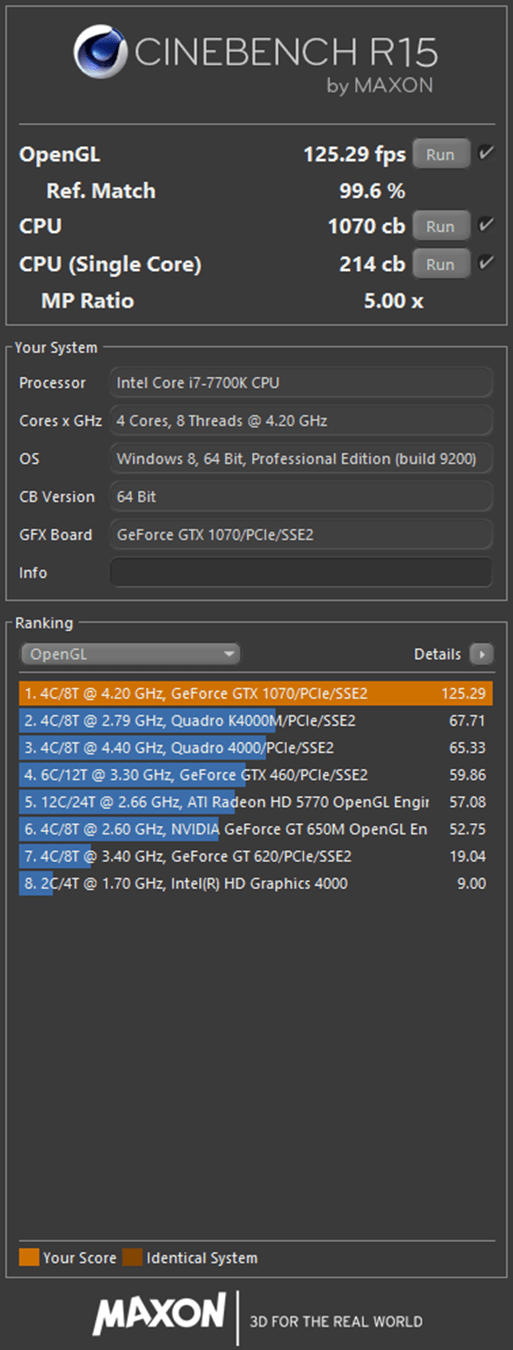
Unigine Heaven
The Heaven Benchmark is a DirectX 11 benchmark designed to stress your GPU under heavy loads. The Heaven Benchmark can be used to determine the stability of a GPU under extremely stressful conditions. I ran the heaven benchmark with the ASUS STRIX GTX 1070 on a custom Preset, Ultra Quality, Extreme Tessellation, AA X8, in 1080p using the DX 11 API. With these settings, the STRIX 1070 received and overall score of 2413 with an average FPS of 95.8, a minimum or 27.6 and a maximum if 213.4.
Gaming Testing Results
Games
Crysis 3
GTA V
Rise of the Tomb Raider
Shadow of Mordor
Thief
Watch Dogs 2
The Witcher 3
As for games, I tested the same seven games I usually test. A mix of older and newer titles, with no games older than 2013. Crysis 3 being the oldest of the titles. However, it’s still one of the most graphically demanding games on the market. Grand Theft Auto V may have launched on the 7th generation of consoles in 2013. However, it didn’t hit PC until 2015 and has one of the most extensive graphics menus I’ve ever seen. Shadow of Mordor is a 2014 title and is still one of the only games to max out the VRAM on a 980 ti when the 4k texture pack is installed. Thief is another 2014 title, but it’s still a beautiful and rather demanding game. I’ve replace the Tomb Raider reboot with its sequel, Rise of the Tomb Raider. I used the Witcher 3 for the fact of how beautiful, popular and very demanding the game is, even on high end systems. Lastly, I recently added Watch Dogs 2 to the suite. This is because it’s a new title and Ubisoft can make a pretty game. They were tested in 1080p, 1440p, and 4k. All games were played at their max settings. Each benchmark run was timed at 120 seconds, ran 3 times each, and averaged out to get the overall results.
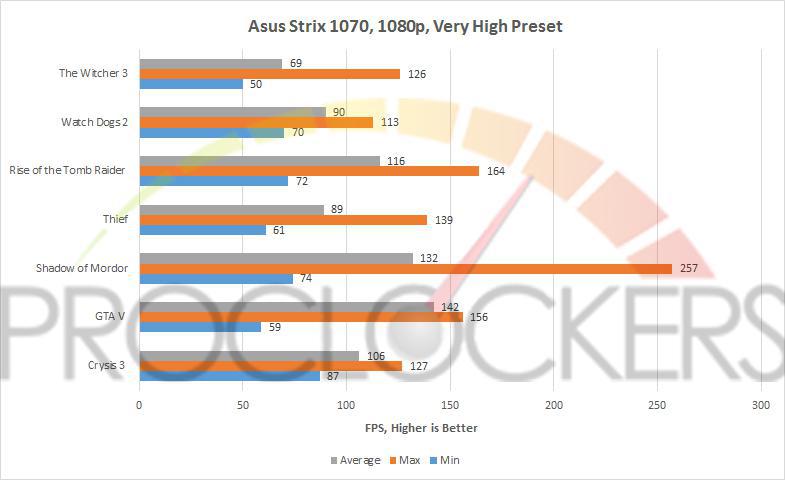
As the chart shows, the STRIX 1070 can easily handle 1080p gaming. You could even say it could be overkill in some games.
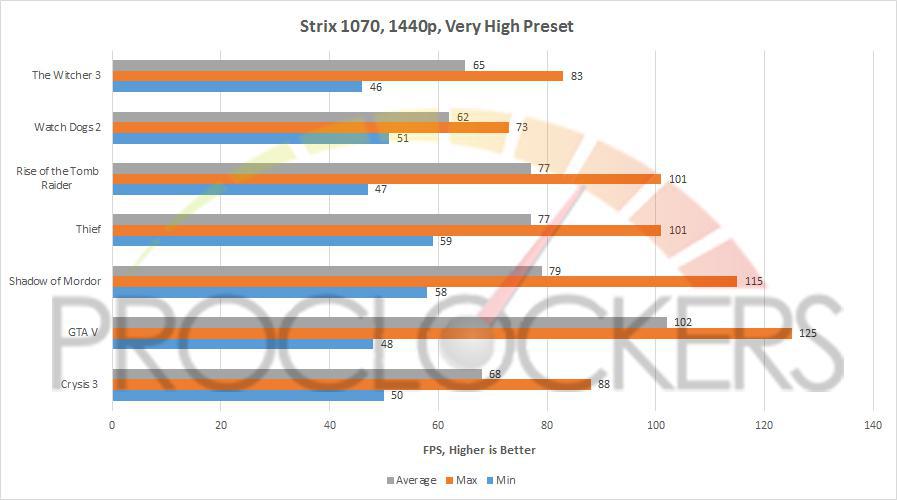
The STRIX 1070 was clearly made with 1440p gaming in mind. Not a single game I tested went below 60 FPS, even at max settings.
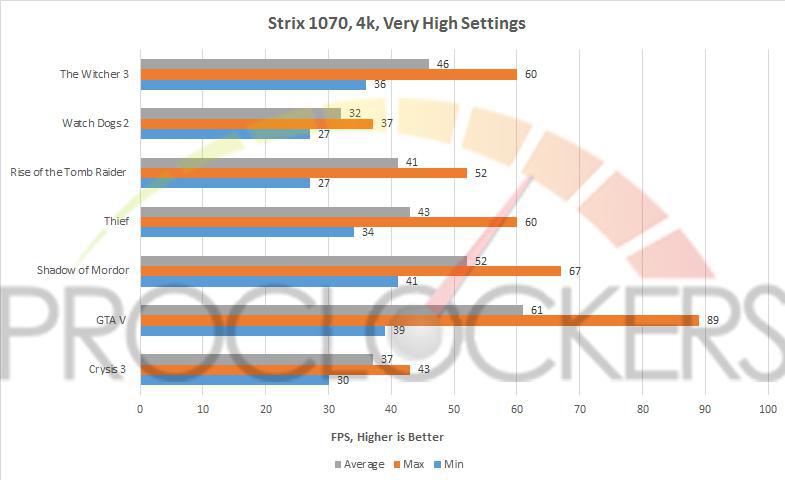
Even at 4k, the STRIX 1070 holds its ground. If you can handle 30 FPS, then this card is all you need for up to 4k gaming. If we lower the setting, we can hit 60 fps in many games, especially older titles.
Overclocking & Temperatures
GPU Tweak II
I used GPU Tweak II to overclock the GPU. In this program, you can choose between 3 modes for your graphics card. OC mode, Gaming mode and Silent mode. The card comes factory set in Gaming mode. If you use another tweaking utility, such as MSI Afterburner, you won’t be able to switch modes. I ran all my benchmarks in OC mode. There are also graphs to the left to monitor everything from GPU core clock, voltage memory clock, fan speed and more. The Gaming booster optimizes your system by setting the system for the best visuals, killing the Windows services and processes and even defragging system memory. There is also an advanced mode where you can manually tweak everything on your GPU.
Here is how Basic mode looks with one touch overclocking by switching modes.
This is how Advanced mode looks. These are also the settings I used while overclocking.
3DMARK

3DMark is a computer benchmarking tool created and developed by Futuremark used to determine the performance of a computer’s 3D graphic rendering and CPU workload processing capabilities. It does this through a series of graphics and physics and or CPU tests. I used 3DMarks most popular benchmark, Firestrike as well as their newest DX12 benchmark, Time Spy to test the ROG STRIX 1070. I tested at both stock and overclocked to +91 on the core and +250 on the memory.
I ran both Firestrike and the new DX12 benchmark, Time Spy. The STRIX 1070 was set in OC mode in GPU Tweak II. The base clock was 1657 and the boost clock is set to 1860 MHz in OC mode. That’s a decent set up from the 1632 MHz in standard mode. While in OC mode, thanks to GPU Boost 3.0, we hit 2000 MHz on the core, with no overclock. Then I applied the max overclock on the core allowed by GPU Tweak II, a +91 on the core, and I hit 2076 on the core.
As I mentioned earlier, ambient temperature was about 22°c or 72°f in my office at the time of testing. That’s a bit warmer then I like to run benchmarks at. The ROG STRIX 1070 never went over 72°c, even under heavy load. While in game, it stayed around 65°c. Another huge plus to the STRIX 1070 was the noise levels. This card is quiet, I mean very quiet. The card, at idle, was running at about 32-34 decibels. Even better, was while gaming, the card stayed right around 40 decibels. Overall, I was happy with these results.
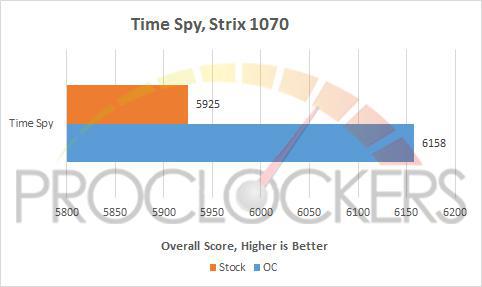
There wasn’t much of a difference between the stock and overclocked results in the DX12 Time Spy benchmark.
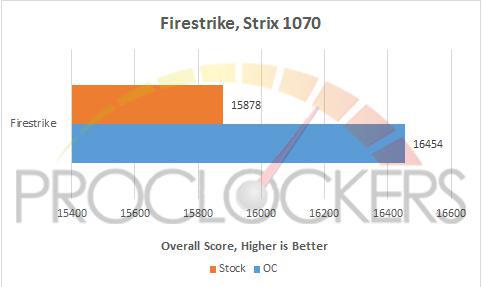
Firestrike showed more of an improvement with the overclock on the GPU.
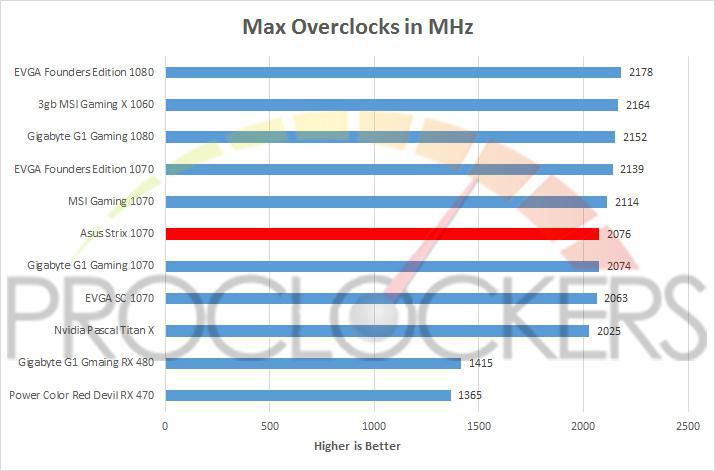
I was hoping for the STRIX 1070 to break 2100 MHz. However, 2076 is still a great overclock.
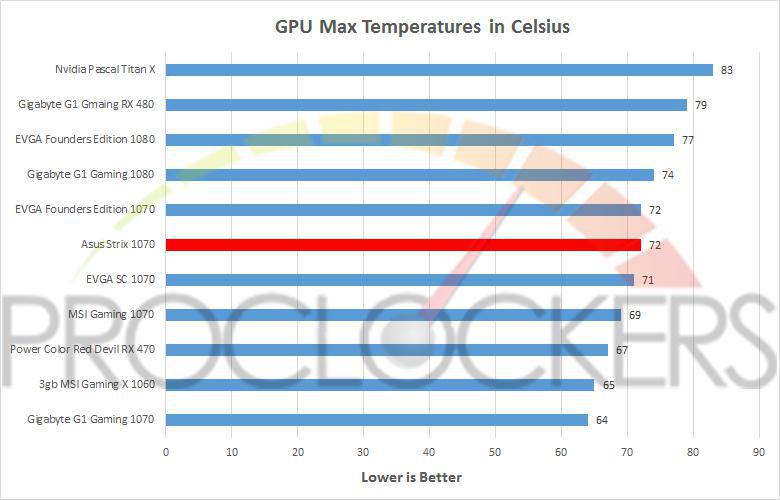
Temperature wise, the ASUS STRIX 1070 was about average when compared to the current generation cards I’ve personally tested since Pascal launched.
Final Thoughts & Conclusion
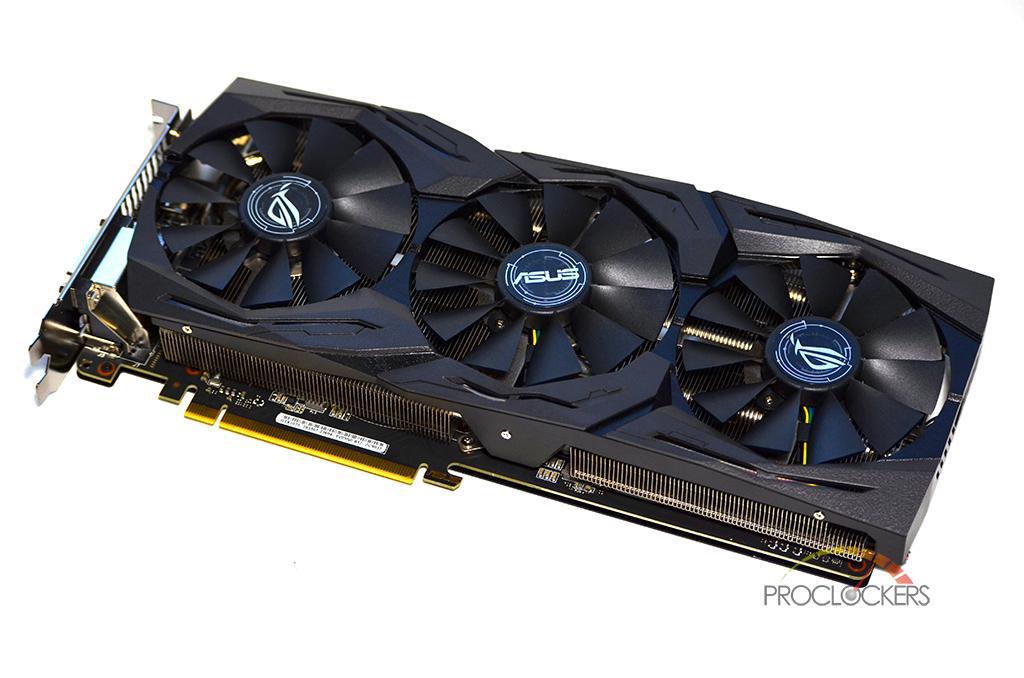
The STRIX 1070 has RGB lighting that can be customized using the AURA Lighting software.
I think it’s safe to say that just about anything with the ROG logo printed on it, is going to be a great product, especially when its paired with the Nvidia logo. The ROG STRIX 1070 did not disappoint at all. Especially if you’re setting up your system for VR sometime in the future, the STRIX 1070 is a great choice due to its dual HDMI ports. I do however wish they has sacrificed the loan DVI-D port over one of the DisplayPort’s for that second HDMI port. With that, I do love the addition of the two 4-pin fans headers on the card. Having the ability to control 2 of the case fans with the GPU is a great feature. I now have an intake and the exhaust synced with the fans on the GPU. Now the exhaust ramps up as the GPU heats up.
The performance of the card is great. The STRIX 1070 absolutely dominates 1080p gaming. It seems to me that this card is more suited for 1440p gaming, or 1080p at 144 Hz. In both cases, it does excellent. Not once in my testing did the STRIX 1070 go below 60 FPS, in any games. It even did well in 4k. Especially since I kept the same max settings I ran all other benchmarks at. All games averaged above 30 FPS in 4k, some even into the 40s in FPS. Lowering the settings in many games can get you around or to 60 FPS, even in 4k. Only during 3DMARK did the temperature get above 70°c. The max temp I hit while running synthetic benchmarks was 72°c. However, during gaming, the STRIX 1070 usually stayed around 65°c. The card not only stayed relatively cool, but quiet as well. The STRIX 1070 never went over 40 decibels, even after an hour of gaming and benchmarking.
Love it or hate it, but it seems RGB lighting is here to stay. I personally love RGB lighting on certain things, graphics cards are one of them. When done right, RGB lighting can really add to a builds personality, The ROG STRIX 1070 does the RGB lighting right. The back plate looks great and with the AURA software, you can customize to fit your build. You can even set the RGB lighting to go along with music. The AURA software and GPU Tweak II couldn’t be easier to use.
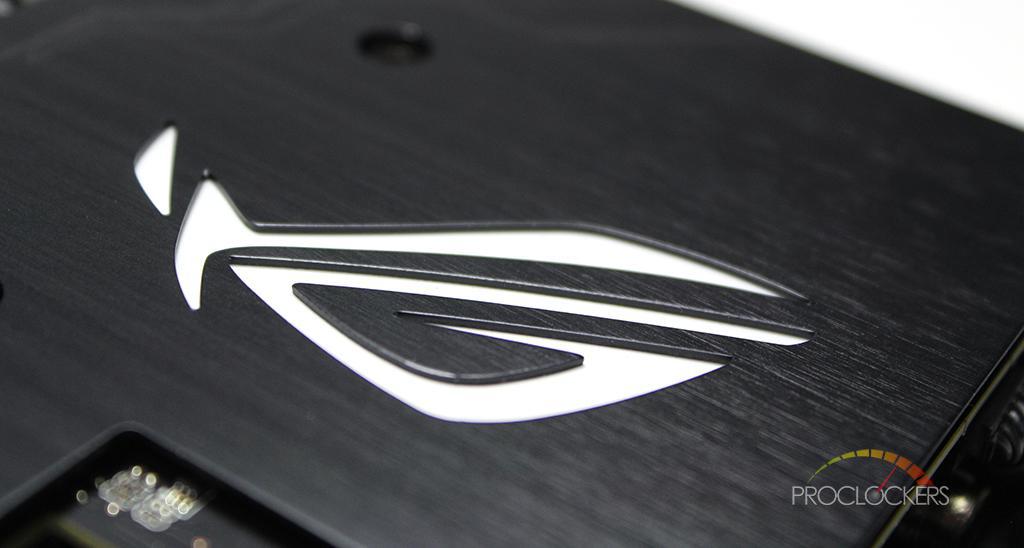
As you may be able to tell, I love this card. It’s already a great looking card, and the RGB lighting just enhances the aesthetic of the STRIX 1070. The price to performance blows away that of the 1080 by far. Especially where at the time of the review, with a $20 mail in rebate, you can get the Asus ROG STRIX 1070 for only $399.02 on Amazon right now. This isn’t only, in my opinion, the best looking 1070 on the market, and one of the best performing cards you can buy, but at that price, it’s one of the cheapest 1070s you can buy. The combination of features, aesthetics, performance and price, I’m happy to give the ASUS STRIX GTX 1070 the ProClockers “Editor’s Choice” award. If you’re about to do a new build or just looking to upgrade an older card, do yourself a favor and grab the ROG STRIX 1070. You won’t be disappointed.







